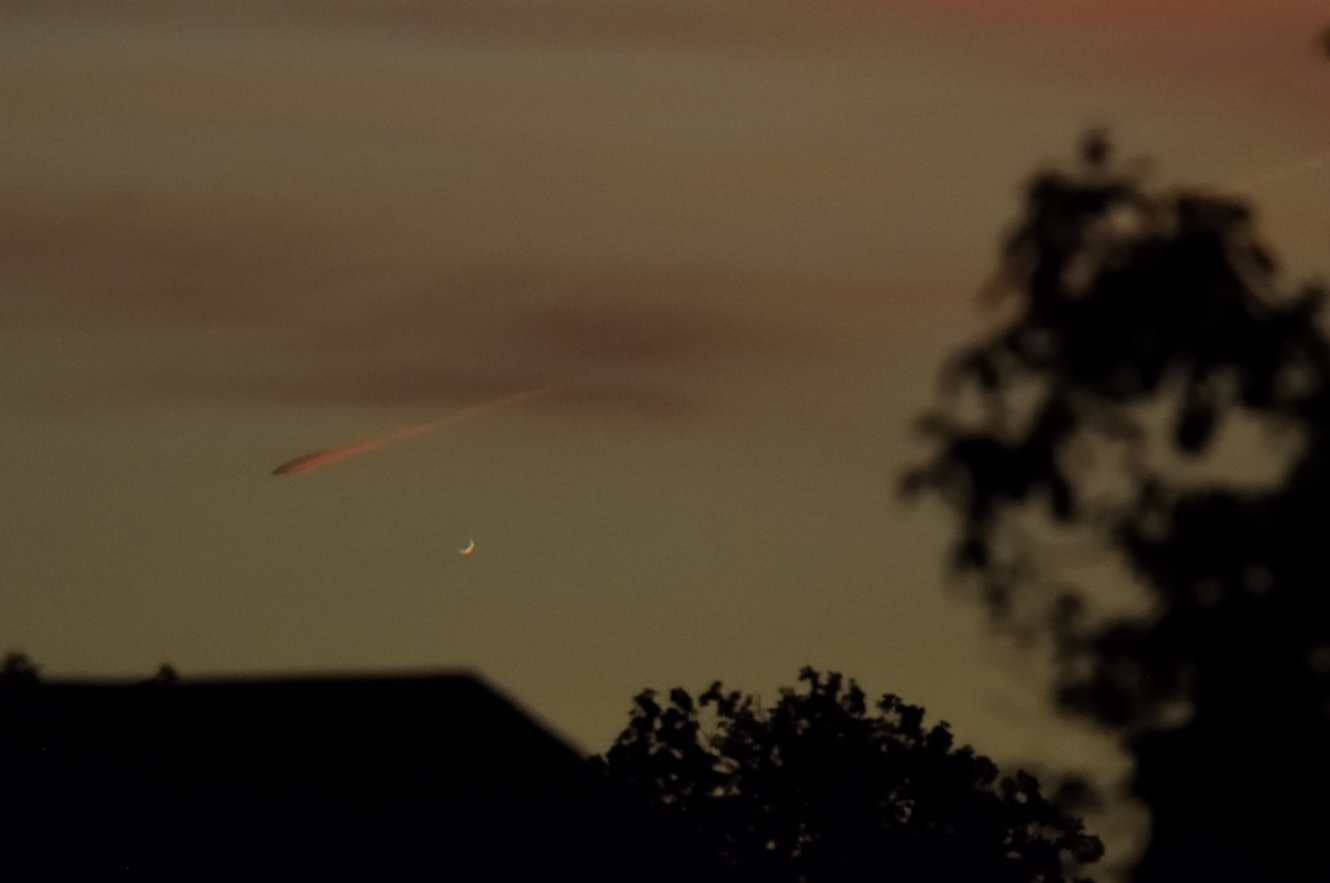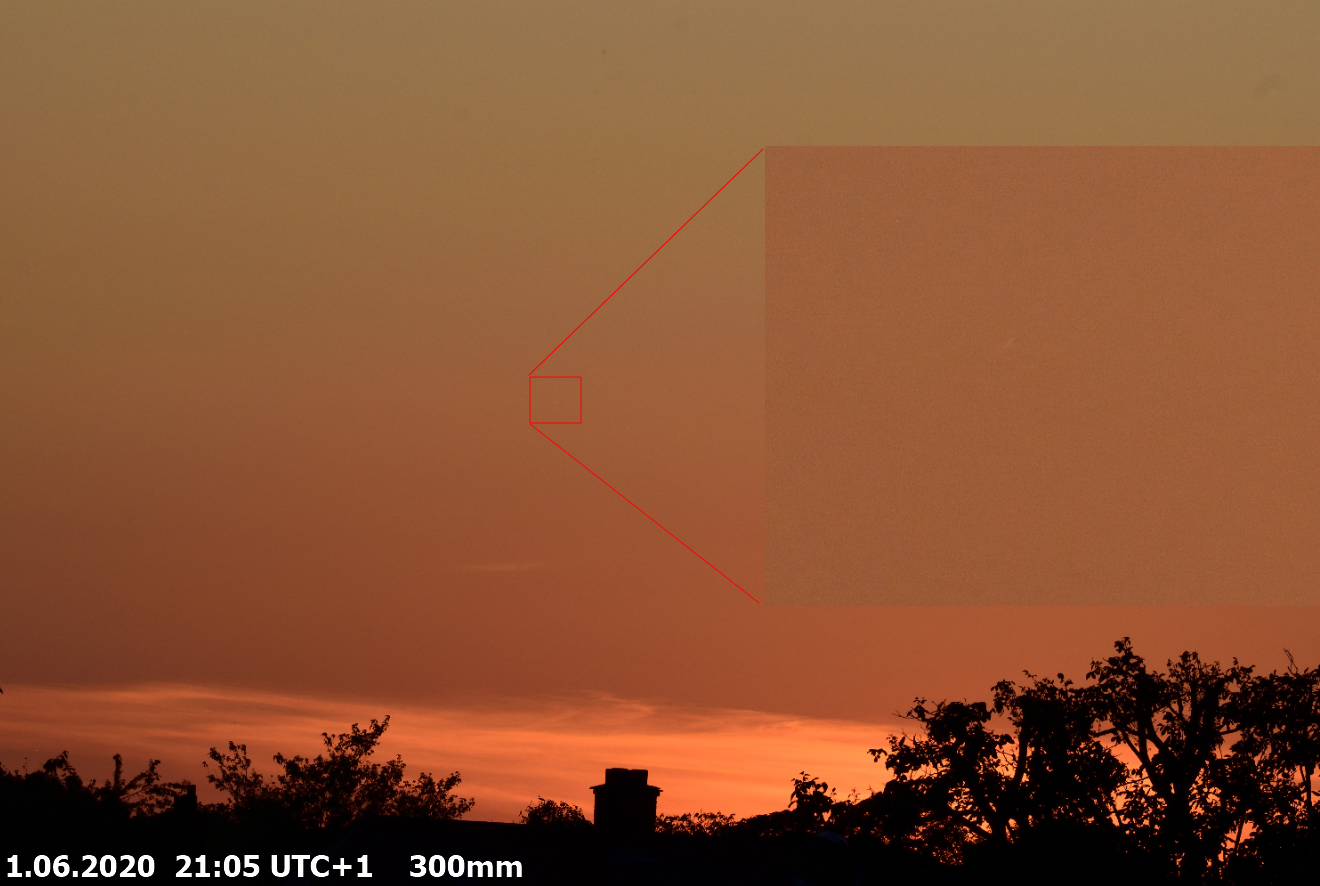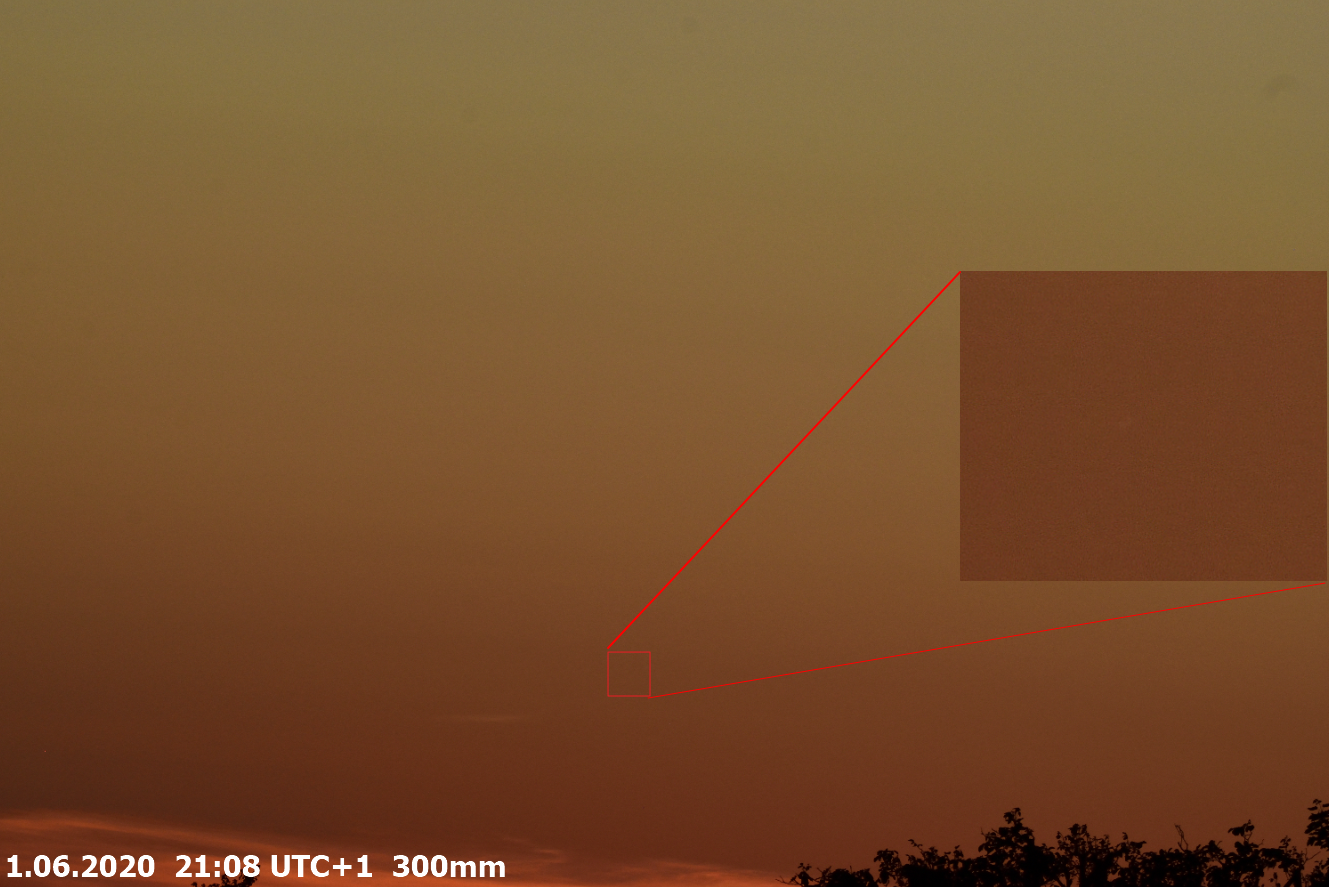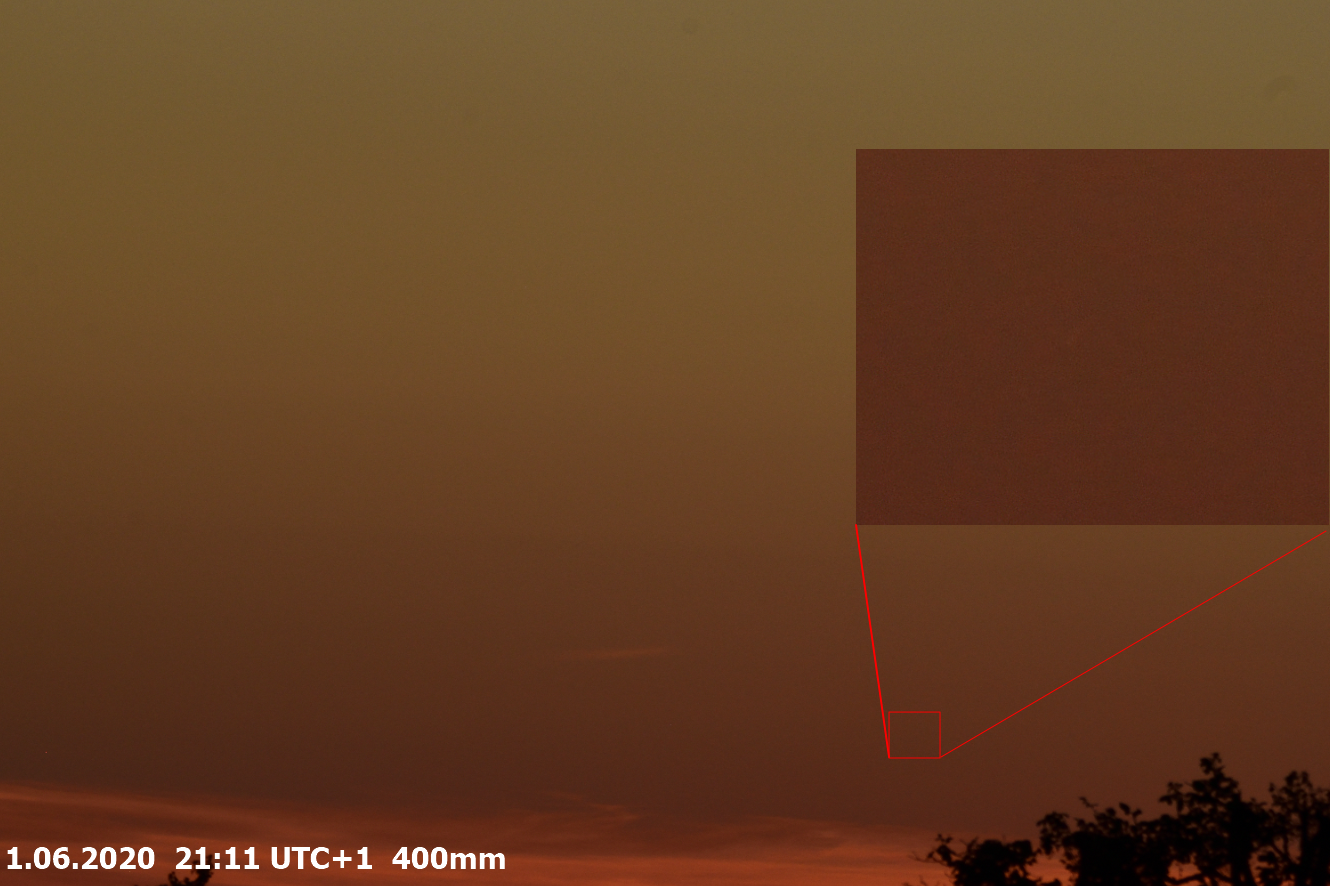The inferior conjunction of Venus with the Sun happens almost every year. Almost, because in about the 8-year cycle of our neighbor planet she passes the Sun-Earth line 5 times (the synodic cycle counts 854 days exactly), making a peculiar pentagram, comprised of 5 petals. Every petal corresponds to the individual character of the inferior conjunction observed. For the sake of simplification, we can assume, that within the 8-year cycle of our planet, we have somewhat 5 original and repeatable inferior conjunctions with the Sun. It applies to the exterior conjunctions too, but the planet doesn’t look as much interesting around these moments as her distance to the Earth is the smallest. Obviously, these inferior conjunctions are subject the long-term changes within the geometry and timing. As a result of such, for instance, we cannot watch Venus passing through the solar disk every year. Recently we could see the transit in 2012. Now, Venus passed close to the Sun on June 3, being just 13 arcminutes above the solar limb and 29 arcminutes from the solar center. This is for sure one of the closest inferior conjunctions excluding the transits across the solar disk. Looking at the graph below, we can see, that there is no closer Venus approaching in the nearest future if we take into account all 5 individual series (“seasons “) (Pic. 1).
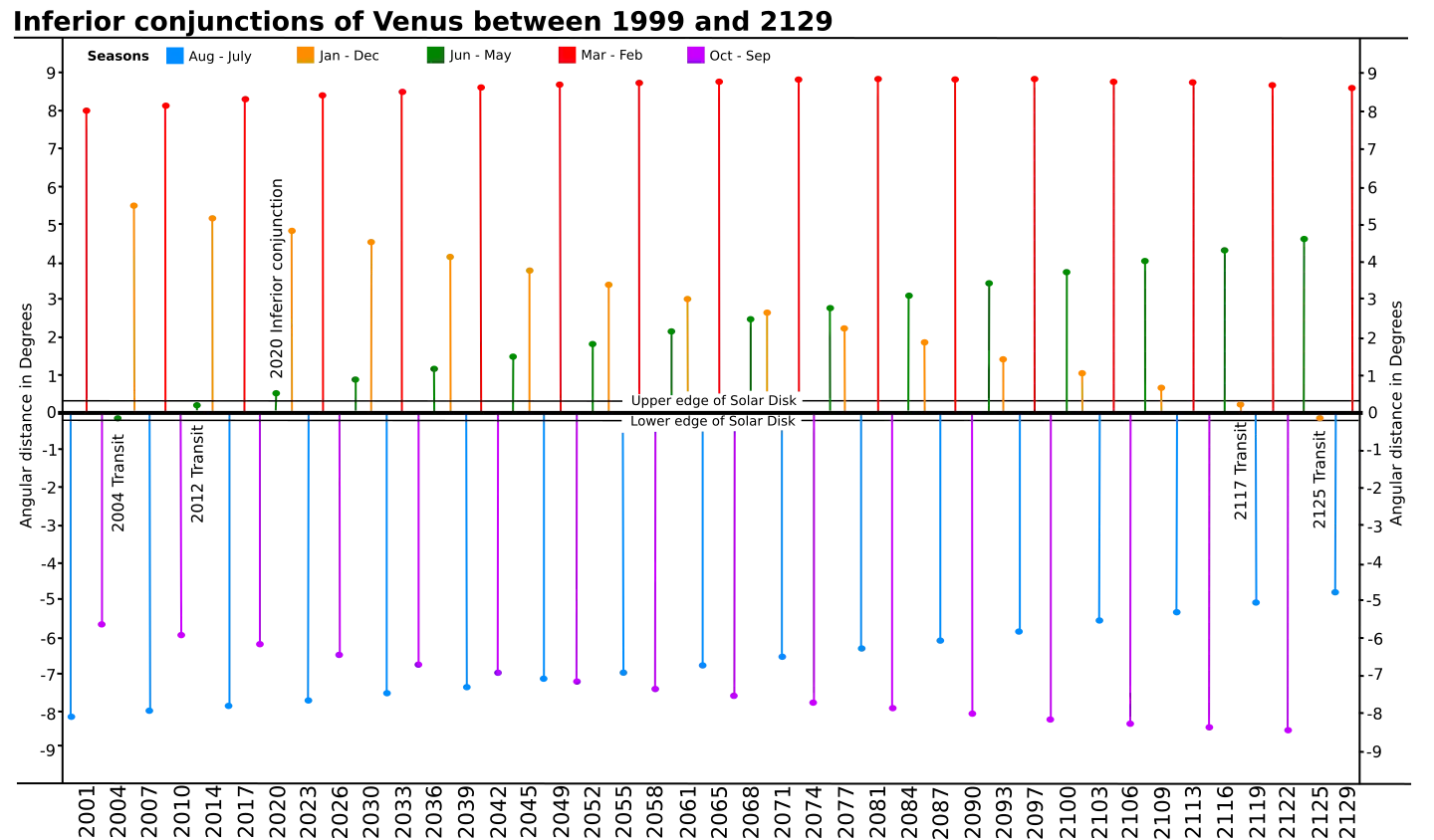
Looking at the pattern above, we should consider only 2 of 5 series of inferior conjunctions. One of them is actually happening. This is the June – May series resulting in two transits across the solar disk recently. Next, it marks the recent, very close inferior conjunction to the Sun in 2020. Other ones, which should bring attention, especially for our descendants belong to the January – December series. Now, Venus still passes the Sun far away during the inferior conjunction at that time, but it gradually changes. Finally, the similar inferior conjunction, as we could observe in 2020 is going to happen in December 2109. In conclusion, the transits happened in the span of 121,5 and 105,5 years. The most effective inferior conjunctions occur in the span of 105,5 and 89,5 years. The 2020 inferior conjunction was analog to the 1996 inferior conjunction, where Venus missed the solar disk on the other side. The green bars representing the Jun – May inferior conjunctions move slowly away from the Sun, and will not result in any transit for the next 3159-3160 years. It was told above, that after the 2020 inferior conjunction, Venus won’t venture as close to the Sun until 2109. The close Venus approaches the Sun as this happens as often as the transits then. This is obviously the simplified understanding, applicable to the one pair of transits. Considering the current time, when the transit of Venus happens twice, the closest venture of Venus to the solar disk occurs also twice – one before the first and another one after the second transit. Sometimes, the Venus transit occurs only once. For descending nodes, to which the 2020 inferior conjunction belongs this situation will start to occur in AD3956. If will be so, the more effective inferior conjunctions will happen. Unlike nearly 13-14 arcminutes, Venus will just miss the Sun twice, passing at about 1,5 arcminute angular distance from the limb. These considerations lead to the final conclusion, which states that the closest inferior conjunctions happen more often than transits. Obviously, all the stuff above explains the importance of these inferior conjunctions. Because at these moments Venus passes the solar disk as close as possible, we can do some interesting observations of the visibility of this planet. Namely, this is a good time for investigating the thick atmosphere of our closest neighbor planet. The total height of Venus’s atmosphere is about 250km. However, the most important element in her structure is the cloud cover. The cloud deck hung in Venus’s atmosphere is comprised of sulfuric acid droplets mostly and reflects about 0.8% of sunlight, making the highest albedo of any planet in the Solar System. These clouds also scatter the sunlight within their layers. Besides clouds, we must also consider a very thick atmosphere as a main factor of the big light refraction. According to Mariner V and Venera probes data results, the refraction is said to be critical. Critical refraction means, that the horizontal ray of electromagnetic radiation would have a curvature equal to the distance from that level to the center of the planet and hence it would be bent into a circle and returned to its original point (Snyder, 1971). The existence of a critical refraction level in the Venus atmosphere can lead to unusual optical effects (Stratton, 1968). Critical refraction doesn’t apply a whole thickness of the atmosphere. It is to be observed at a 35km altitude (probably 20 to 25 km below the top of opaque clouds). If someone could stand on Venus’s surface, he would see the vista through the fish-eye lens. A similar influence of the big refraction takes place in the upper parts of the atmosphere, at the level of thick opaque clouds. The sunlight enters Venus’s dense atmosphere and tends to be significantly bent and scattered as much as deep it filters the atmosphere down to the heavy cloud level. That’s why the Venus silhouette is to be visible even when close to the Sun. Venus clouds are discernible even on the opposite side of the planet, making a strange shape, which remains something like the “ring of fire”. The big refraction phenomenon combined with a high albedo of Venus’s clouds results in the ring-looking silhouette visible even when the planet is quite far from the Sun (Pic. 2).

When Venus is closer to the solar limb, this atmospheric ring looks better. This is the best explanation for the importance of these inferior conjunctions, which occur very close to the Sun. As opposed to these conjunctions, Venus can pass the Sun at a much bigger angular distance. The maximum angle between the Sun and Venus can reach 9 degrees (Pic. 1). In practice, it means, that the planet will remain visible throughout the entire time. Its visibility depends on the location against the Sun. If the conjunction happens, when Venus is south of the Sun then it won’t be visible from the northern hemisphere. It means, that the planet rises later and sets earlier than the Sun. The planet will be observed by a person located in the southern hemisphere because it will rise earlier and set later than the Sun there. For our situation, as occurred in 2020, the maximum angular distance between Venus and the Sun which can be reached during any inferior conjunction occurred on May 29 (Pic. 3).

I was attending to the observations from April when Venus was clearly visible in the evening sky. As we know, it passed close to the Pleiades cluster on April 8. This is the best time to start following Venus because we can observe how the planet changes. It’s obviously the most spectacular period, when Venus changes rapidly, turning its phase into a thin crescent (Pic. 4).
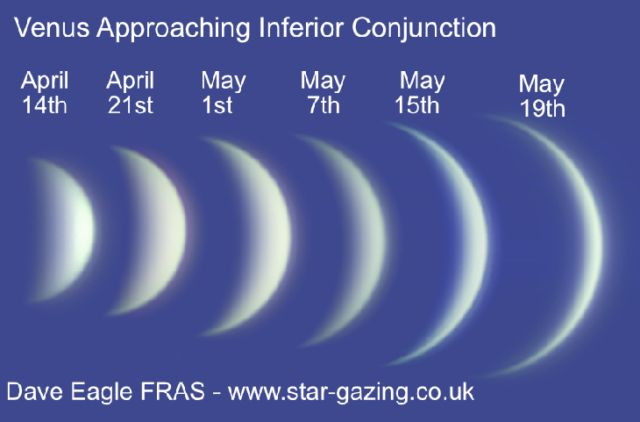
The maximum elongation of the planet means the dichotomy phenomenon (Pic. 4). The dichotomy is the moment when the planet is in its half-phase exactly. In practice, exactly 50% of the disk is illuminated and visible to the observer.
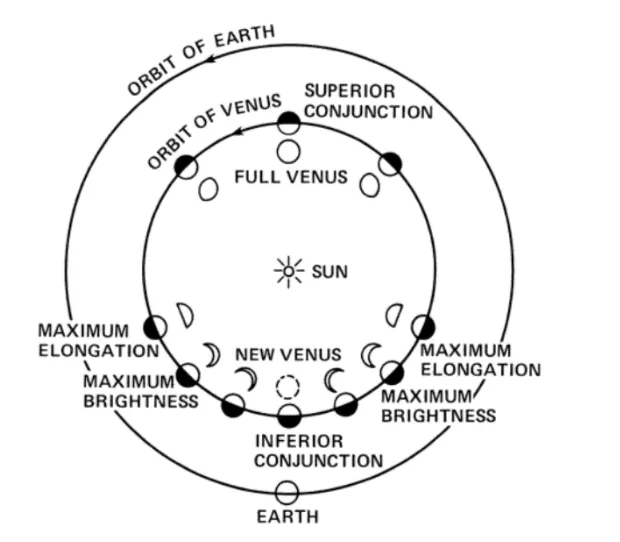
There is one optical illusion, which goes along with the half-phase of our planet. This is the Schroeter effect, which is expressed by phase anomaly. The effect states, that the half-phase appearance falls a few days earlier for the eastern elongations, and a few days later for western elongations. This is driven by the light refraction described above and its further scattering in the atmosphere near the terminator line. In turn, at the maximum elongation, the phase of Venus looks bigger than 50%. In 2020 the maximum elongation of Venus occurred on March 24. The maximum elongation doesn’t indicate the maximum brightness of Venus. It occurs about 36 days later (Hunten, 1983) when the planet moves closer to the Earth and looks bigger at once. It falls around halfway between the maximum elongation and inferior conjunction. The brightness of Venus likewise other planets is determined by 4 factors:
– the planet’s distance from the Sun, determining the intensity of sunlight (inverse-square law)
– the proportion of sunlight hitting the planet, which is reflected back into space (albedo)
– how large the illuminated part of the planet appears in the sky
– the planet’s distance from the Earth and its size, which determines its angular size on the sky
All the aforementioned factors are favorable for Venus. This planet has the biggest albedo in our Solar System, It is located close to the Sun, so it receives almost the biggest amount of sunlight as the second planet in the order. Furthermore, it’s our closest planet. The size, similar to Earth is not as big when compared with other planets in the Solar System, but large enough for Earth’s observer. All these factors contribute to the fact, that Venus is the third brightest object in the sky after Sun and Moon. The overall brightness of Venus varies between -3,4 mag and -4,6 mag. It means, that the apparent brightness of Venus stays within roughly a 1.2 magnitude range throughout its synodic cycle. As said above, the brightest moment occurs halfway between the maximum elongation and the inferior conjunction, when the planet is close to the Earth with a still big illuminated surface visible to us. The brightness around -3 or -4 mag means, that an object can be easily visible in daylight (Pic. 5, 6).
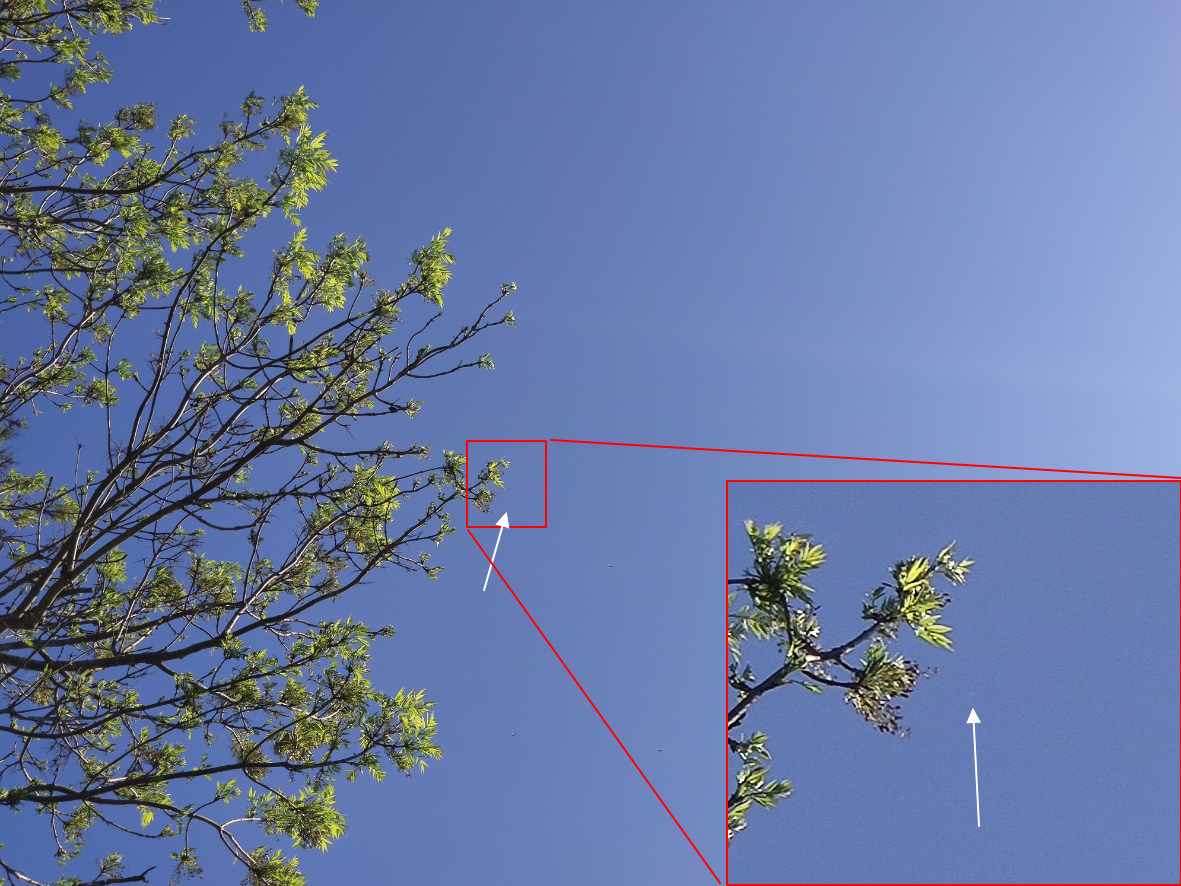
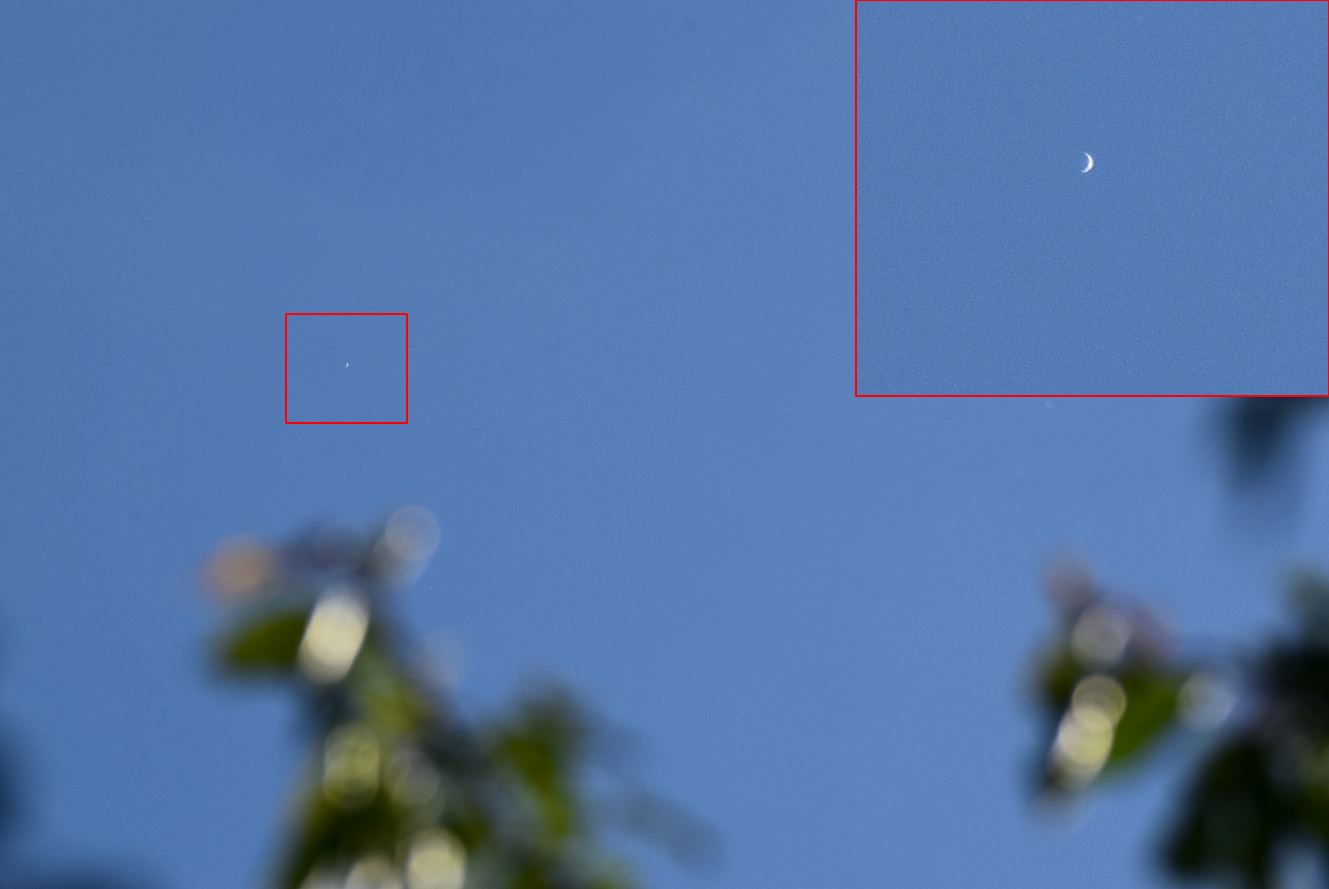
As you can see, the daylight observations of Venus are not difficult and well worth doing so. The basic advantage of these observations is the high position of Venus, which is unaffected by atmospheric turbulence. The image taken by Xiaomi Mi 9 proves, that the planet is to be seen easily by the naked eye. Daylight conditions or the situation, when the Sun is about to rise or just set are the best for observation of Venus. The sky is still bright, and the contrast produced with the evening glow and the visible planet is lower. Thanks to this an observer can distinguish more details.
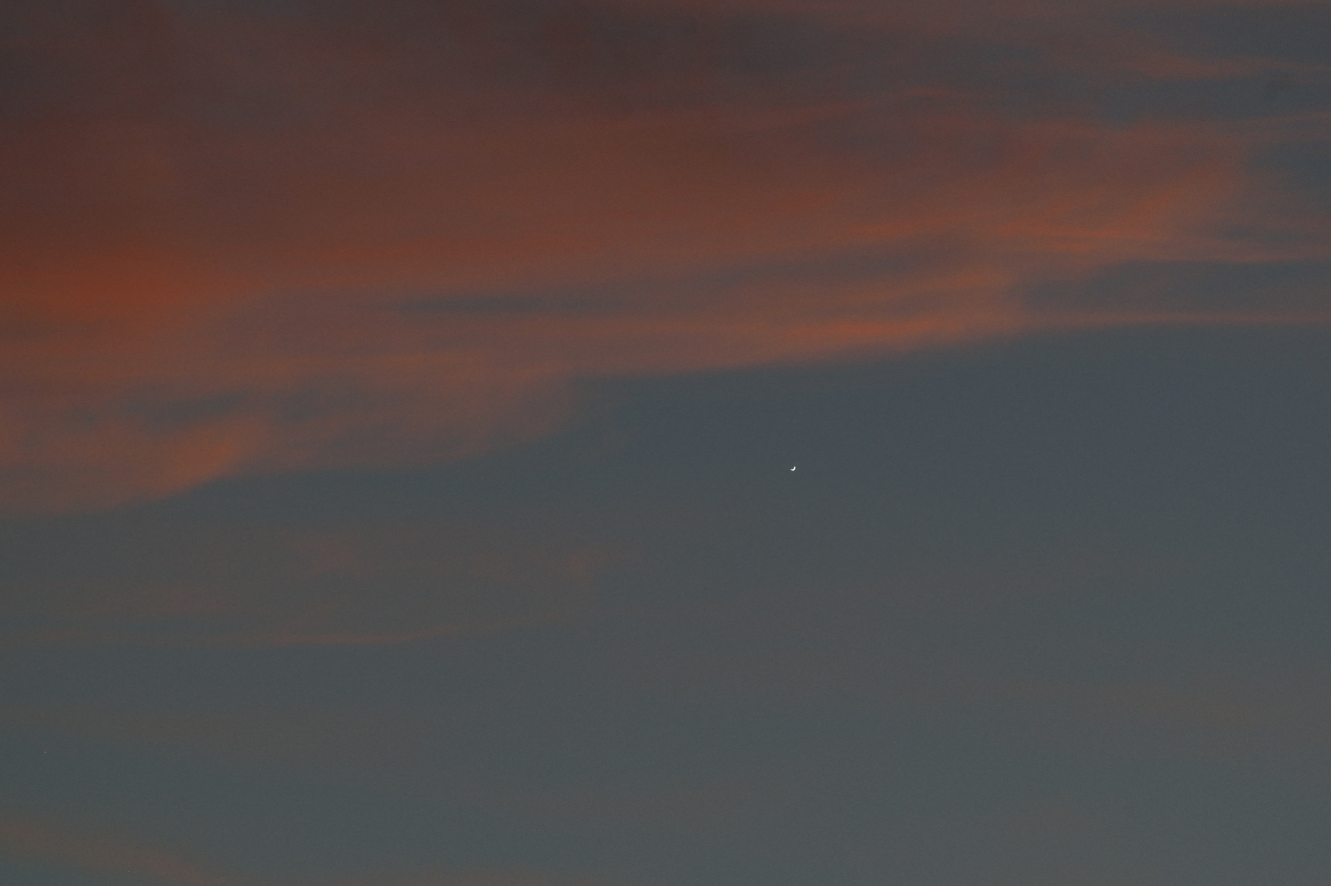
The time to observe Venus is when the planet makes a starburst effect on the dark night or late evening (early morning) sky. The planet disc is too brilliant and has false color effects. Obviously, the thing applies to at least medium telescopes, which are able to distinguish more details than the phase estimates only.

Venus at its maximum brightness is able to shine the vista. I would like to develop this issue in the future. Apart from unusual brightness, the most interesting are the phases of Venus, best visible between the inferior conjunction and the elongation (Pic. 3). As Venus approaches the Sun, we can see how its disk turns into a crescent. Moreover, when the crescent is thin, we can observe the horns of Venus. These horns are lengthening as Venus gets closer to the Sun. This is a specific phenomenon, related to the thick Venus atmosphere described a bit above. Finally, these horns of Venus exceed 180 degrees near the inferior conjunction. In extreme moments, like near 2020 approaching they can join a continuous form called the “Ring of Fire” or “Annular phase of Venus“.
My own observations of Venus were random till May 22, when they became regular. The goal was to check what time before the inferior conjunction Venus would be visible.
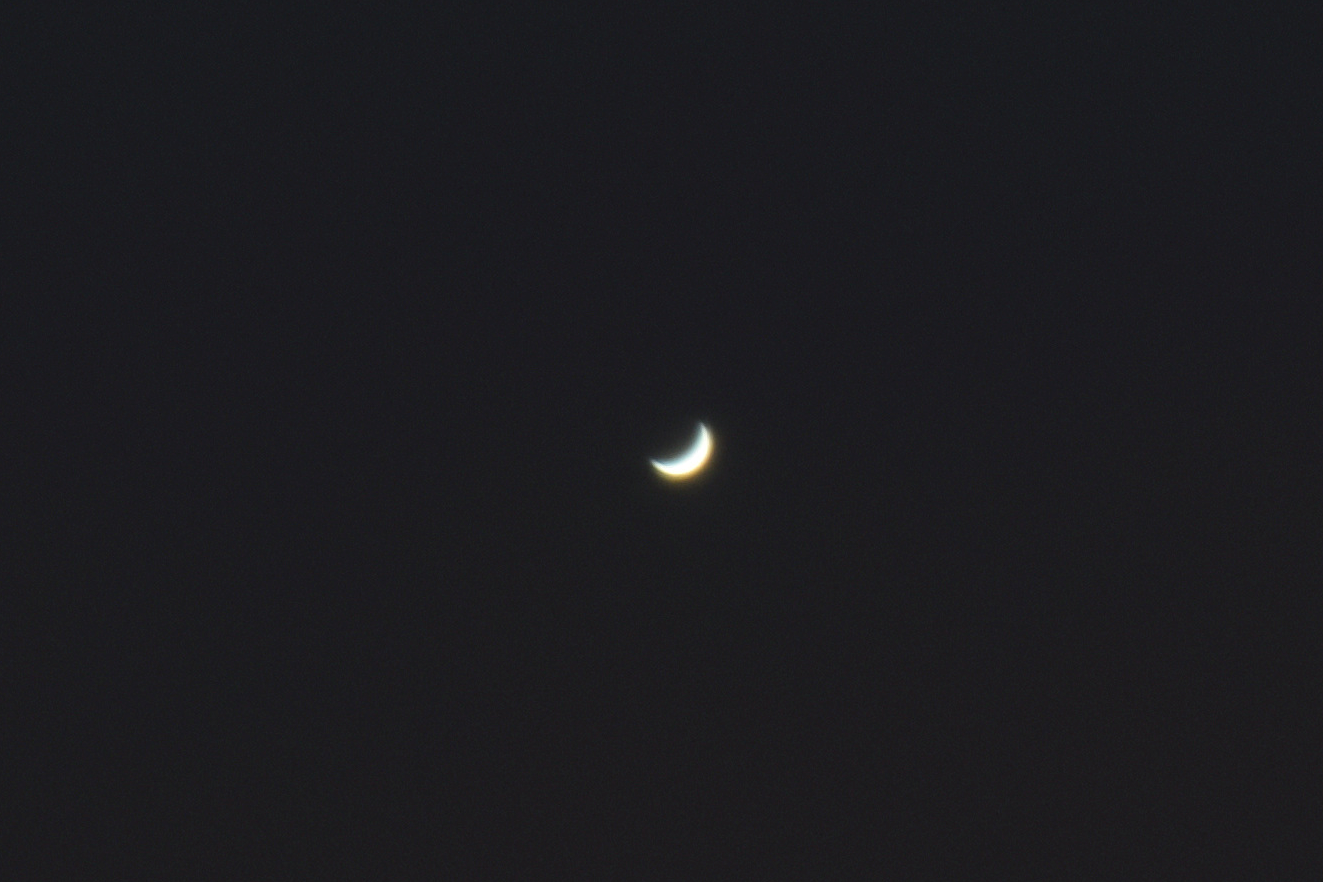
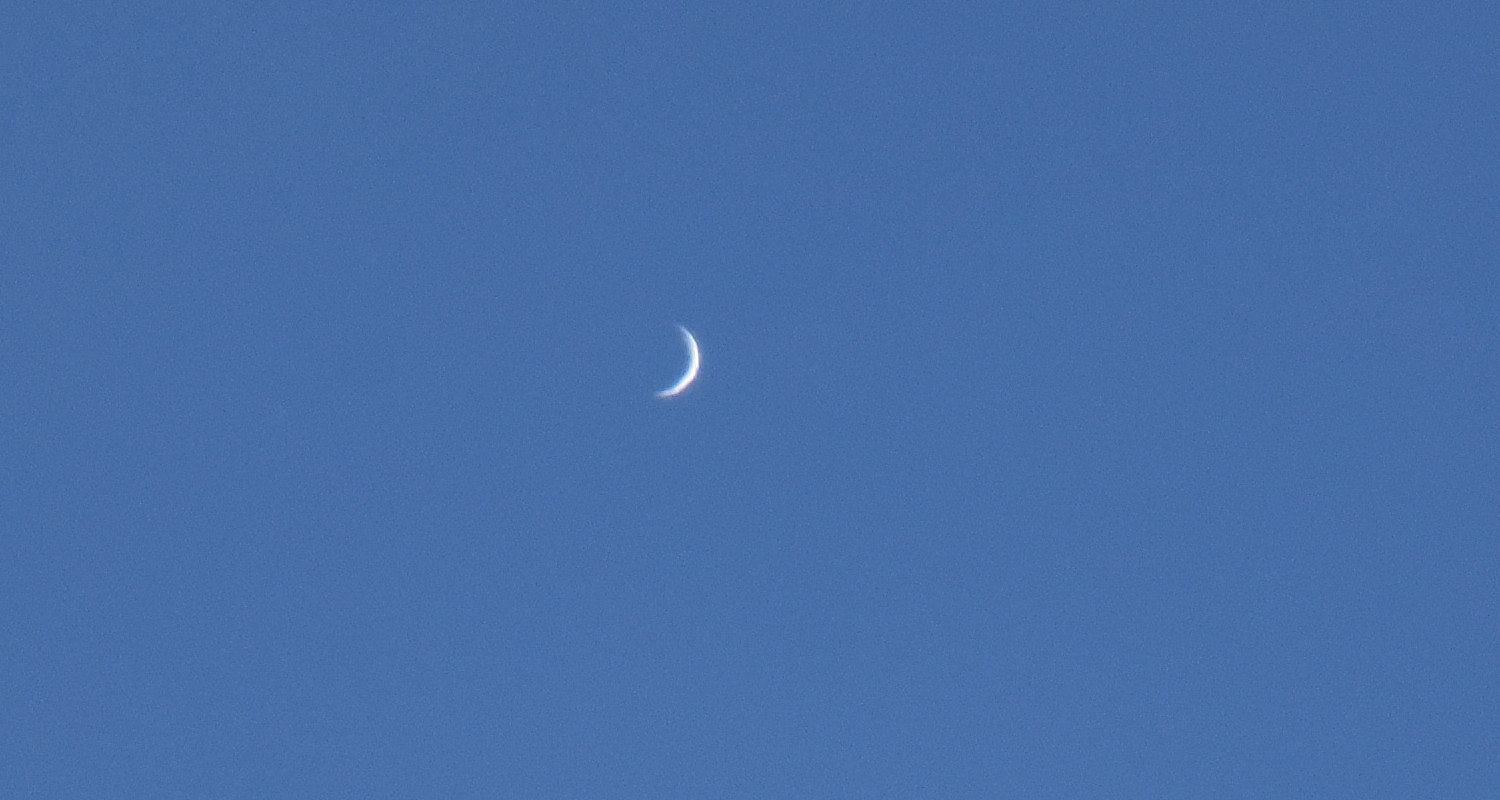
I was observing Venus from the Waterbeach Recreation Ground, usually between 21:00 and 21:40 BST (20:00 – 20:40 UTC). I was attending more or less to the same place, because I wanted to find the planet easily in the sky, having the same horizon exactly. It was really helpful, especially shortly before the conjunction. It led me to see Venus until June 1. I would like to show you the results of my observations below.
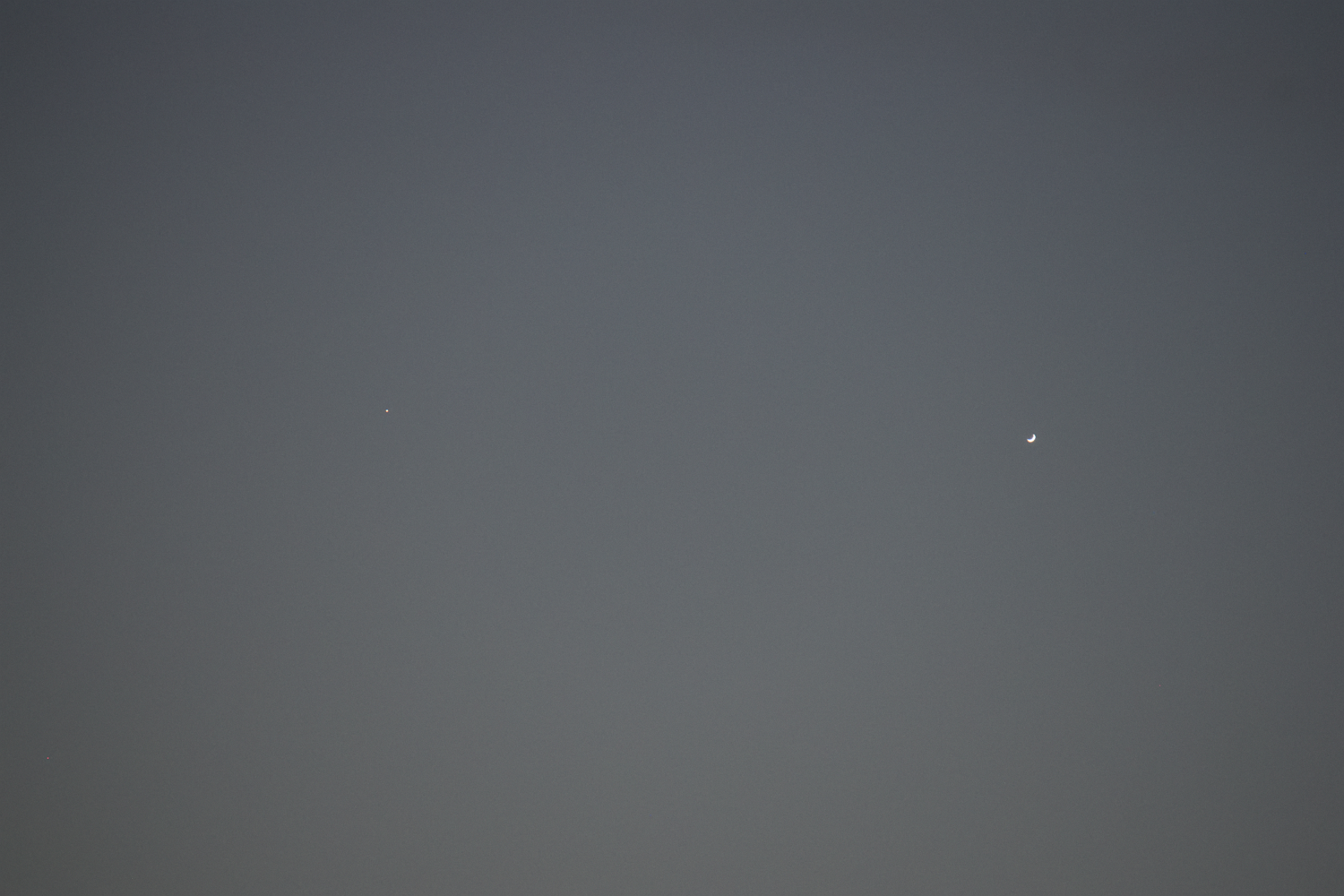

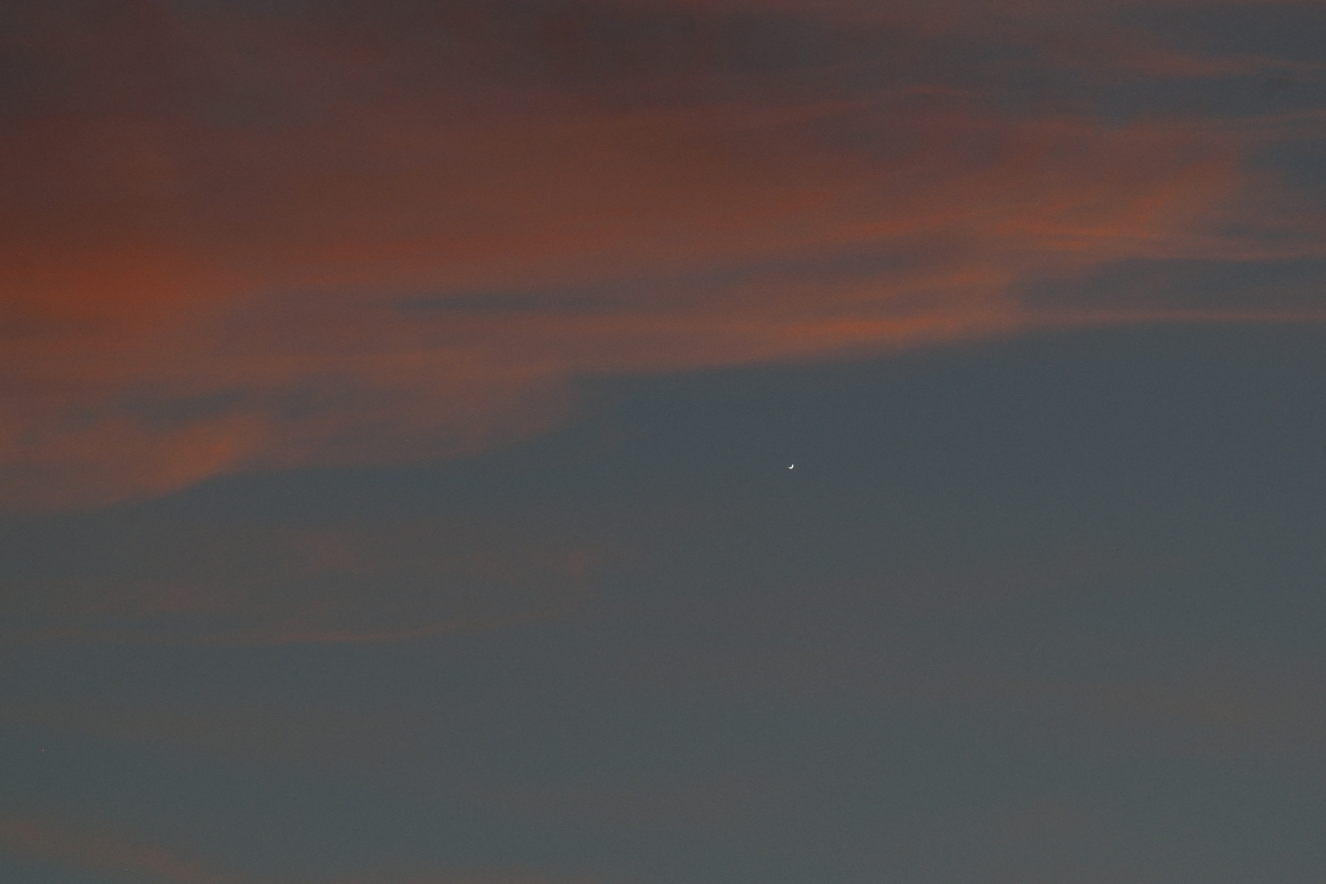

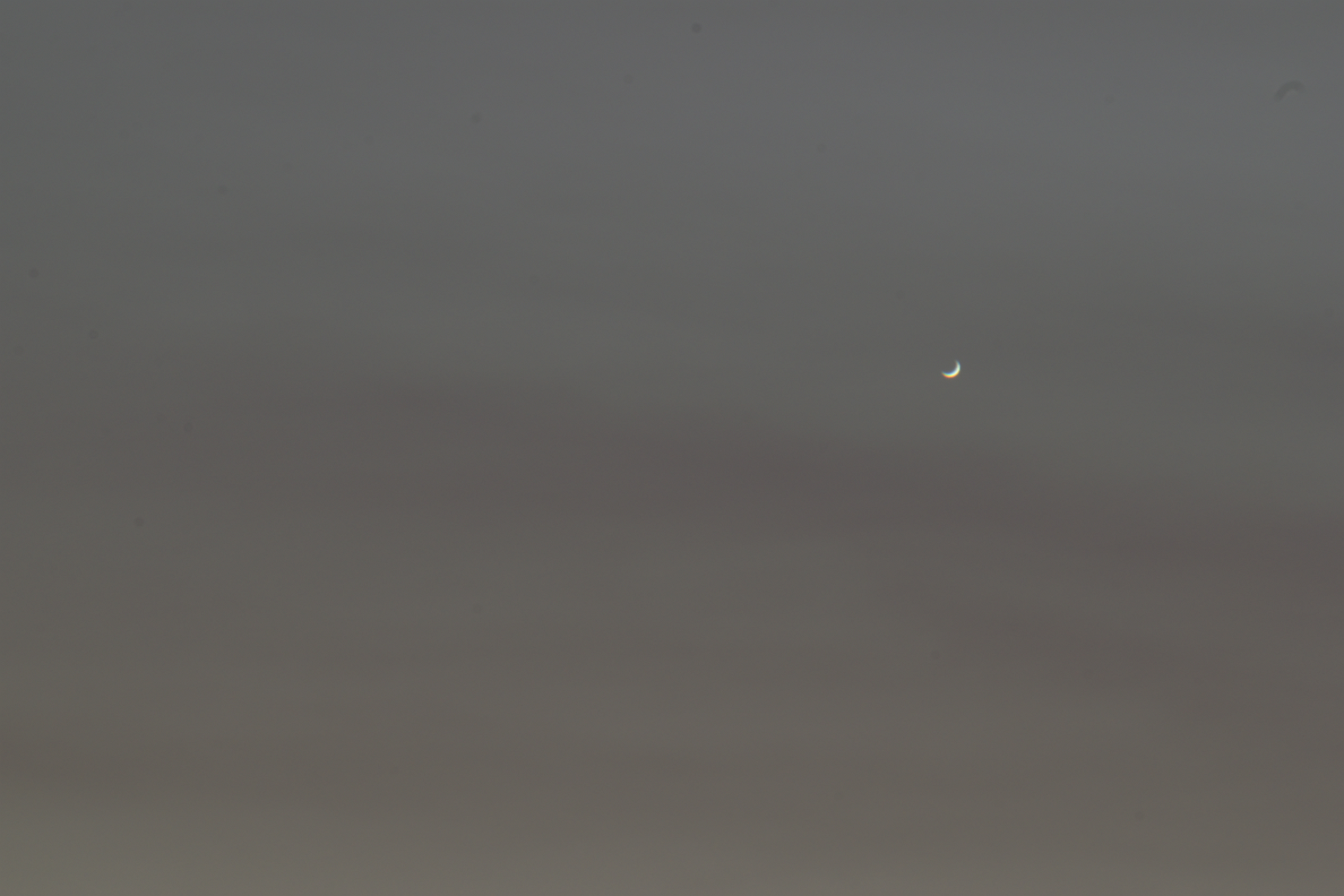
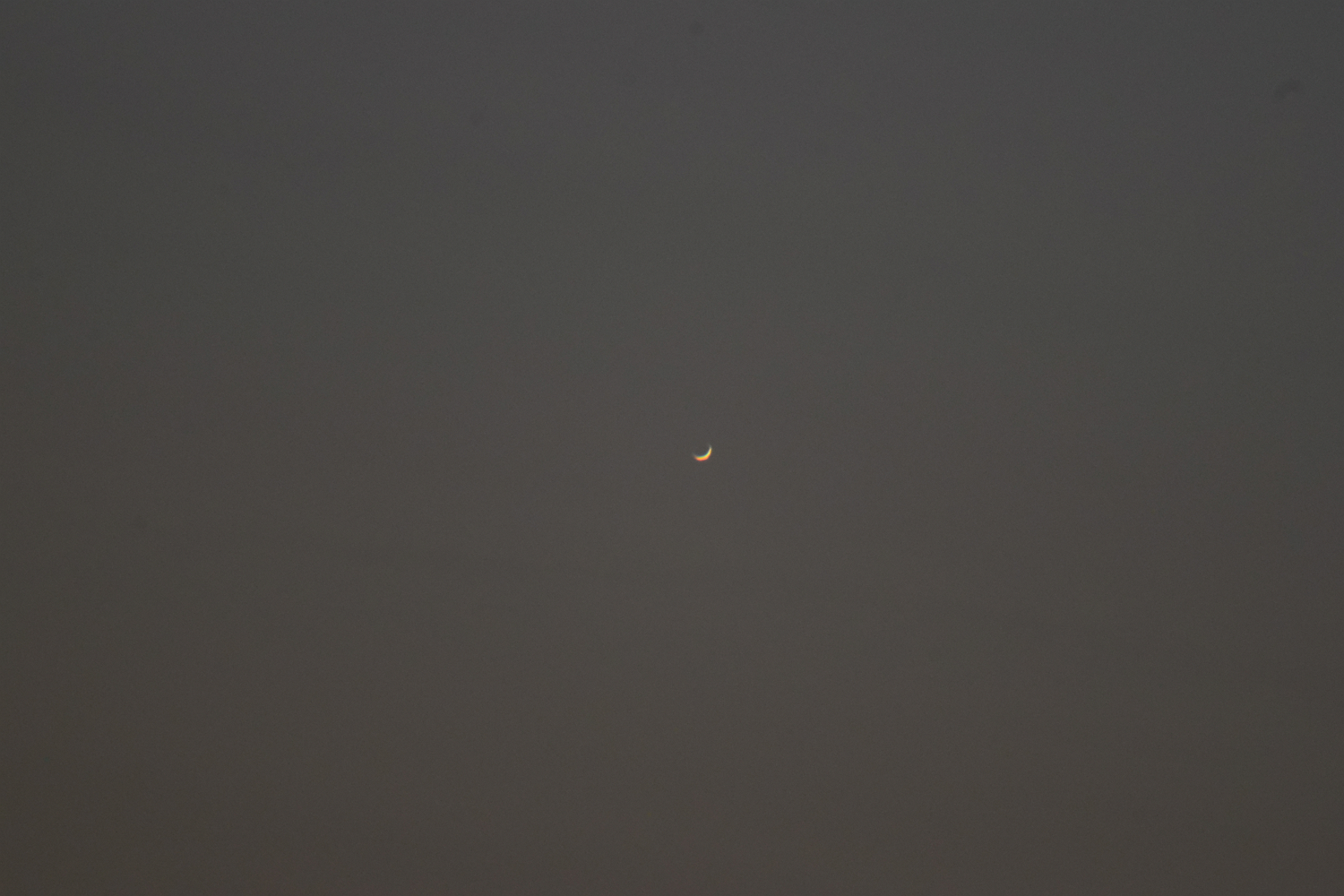
On May 28, exactly 6 days before the inferior conjunction I tried to check the Venus visibility by the naked eye. It was said, that some eagle-eyed humans are able to see the Venus crescent without any additional magnification. Usually, Venus can be seen as a bright dot. The human eye is able to resolve two image elements 60 arcseconds apart. It applies to people with excellent vision. The angular size of Venus on May 28 was about 57 arcminutes. I wasn’t able to dissolve this object in the sky, unfortunately. I’ve prepared some checks with lenses below, starting from 35mm, an adequate lens for my sensor in the Nikon D5300 DSLR camera (Pic. 16 – 24).
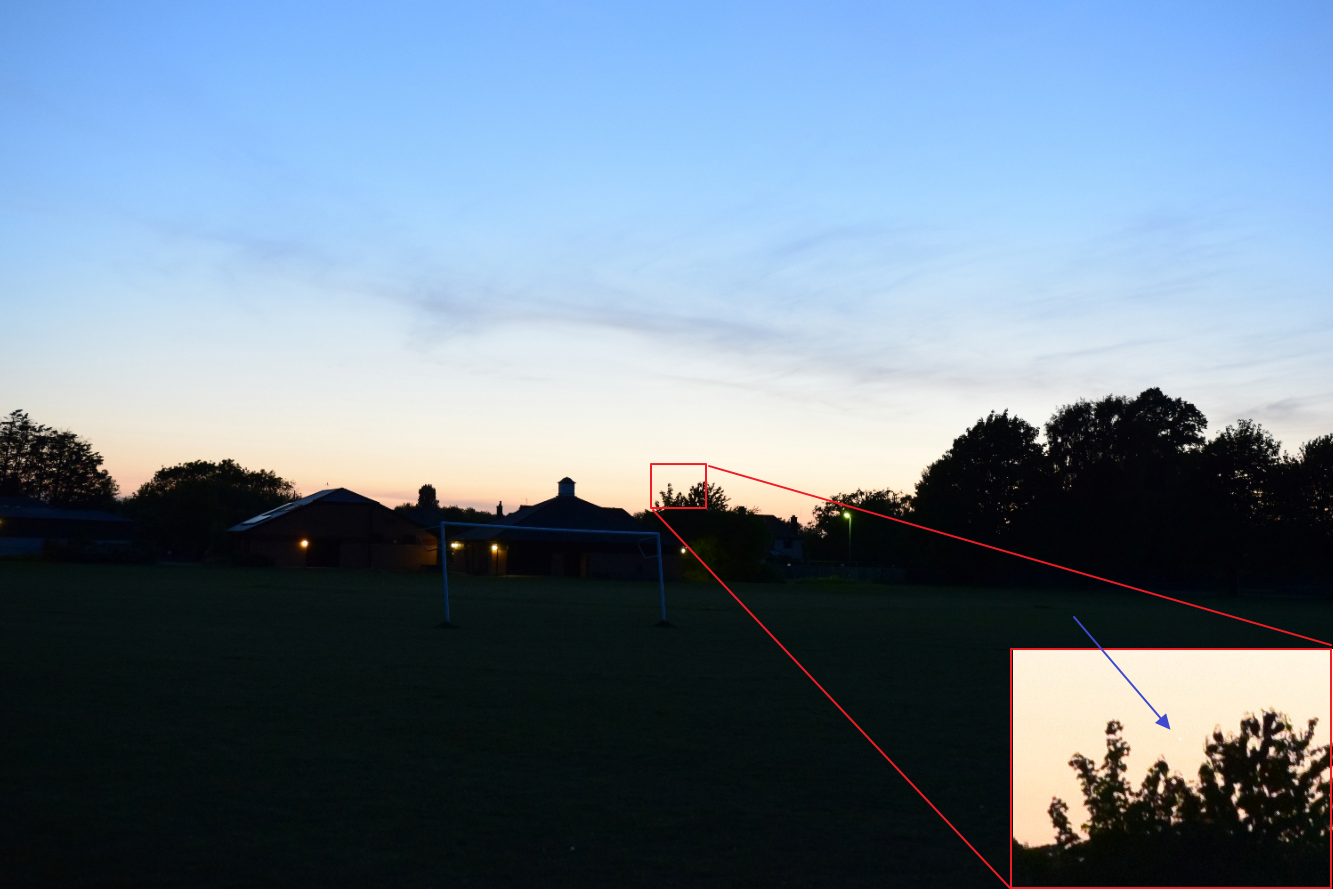
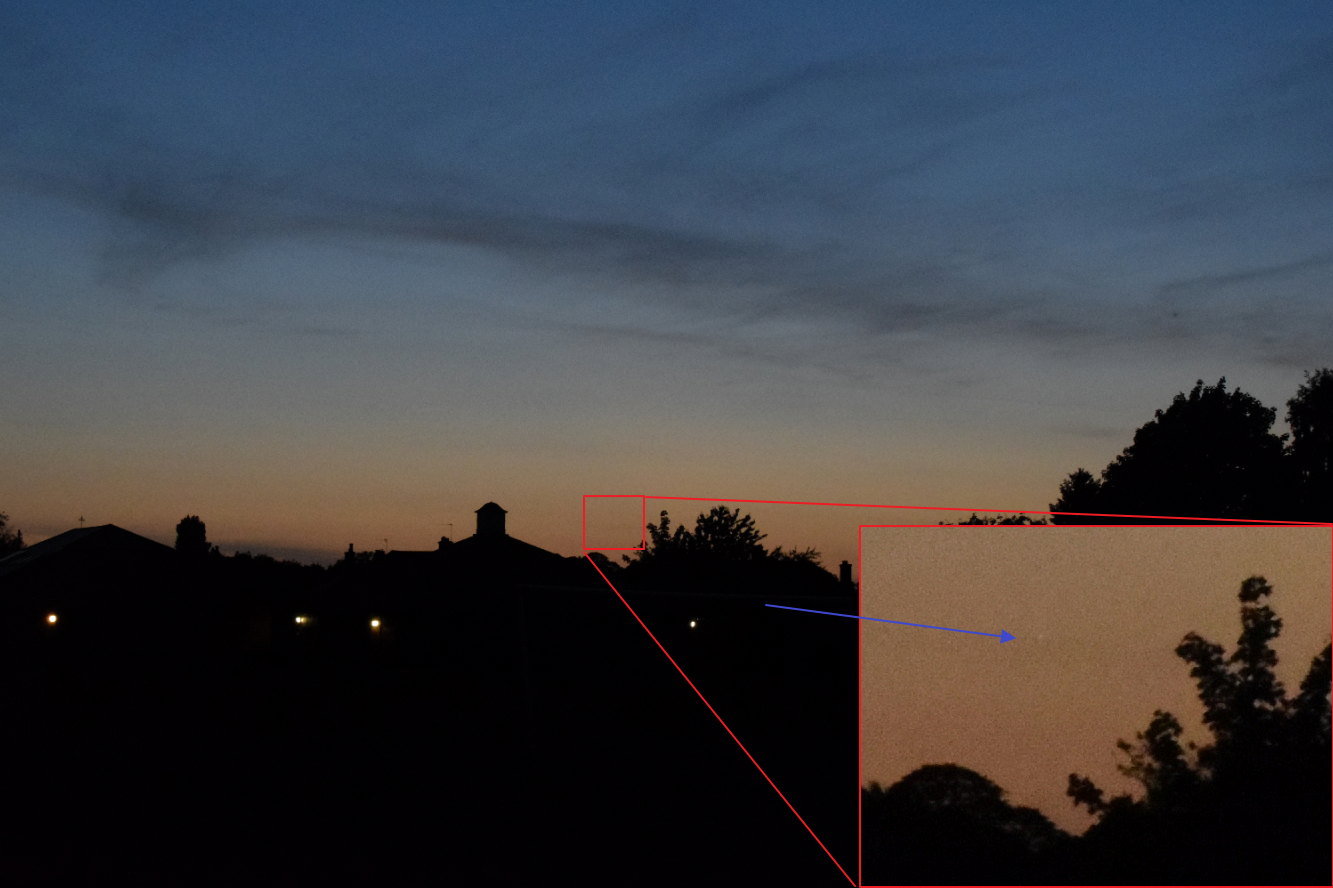
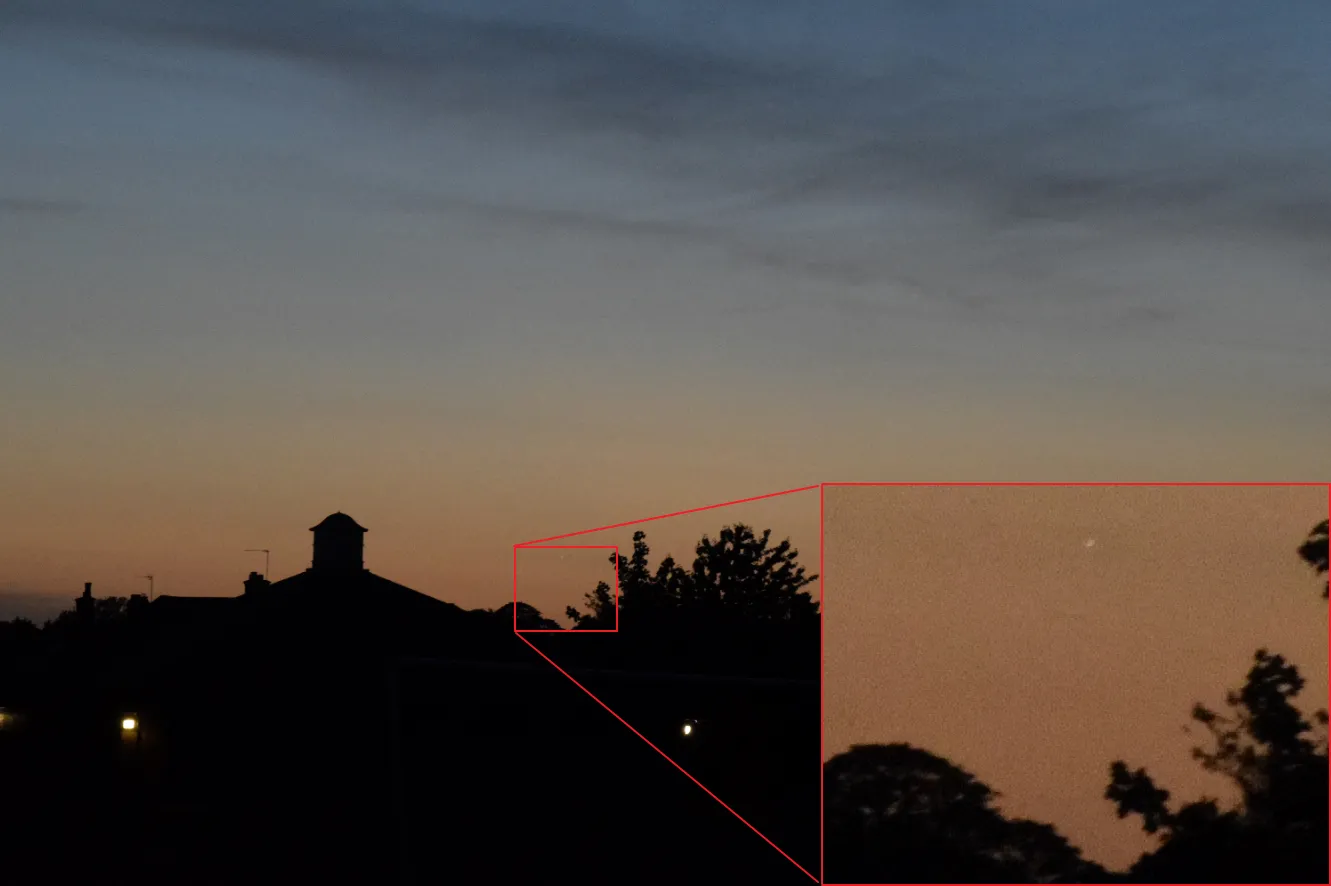
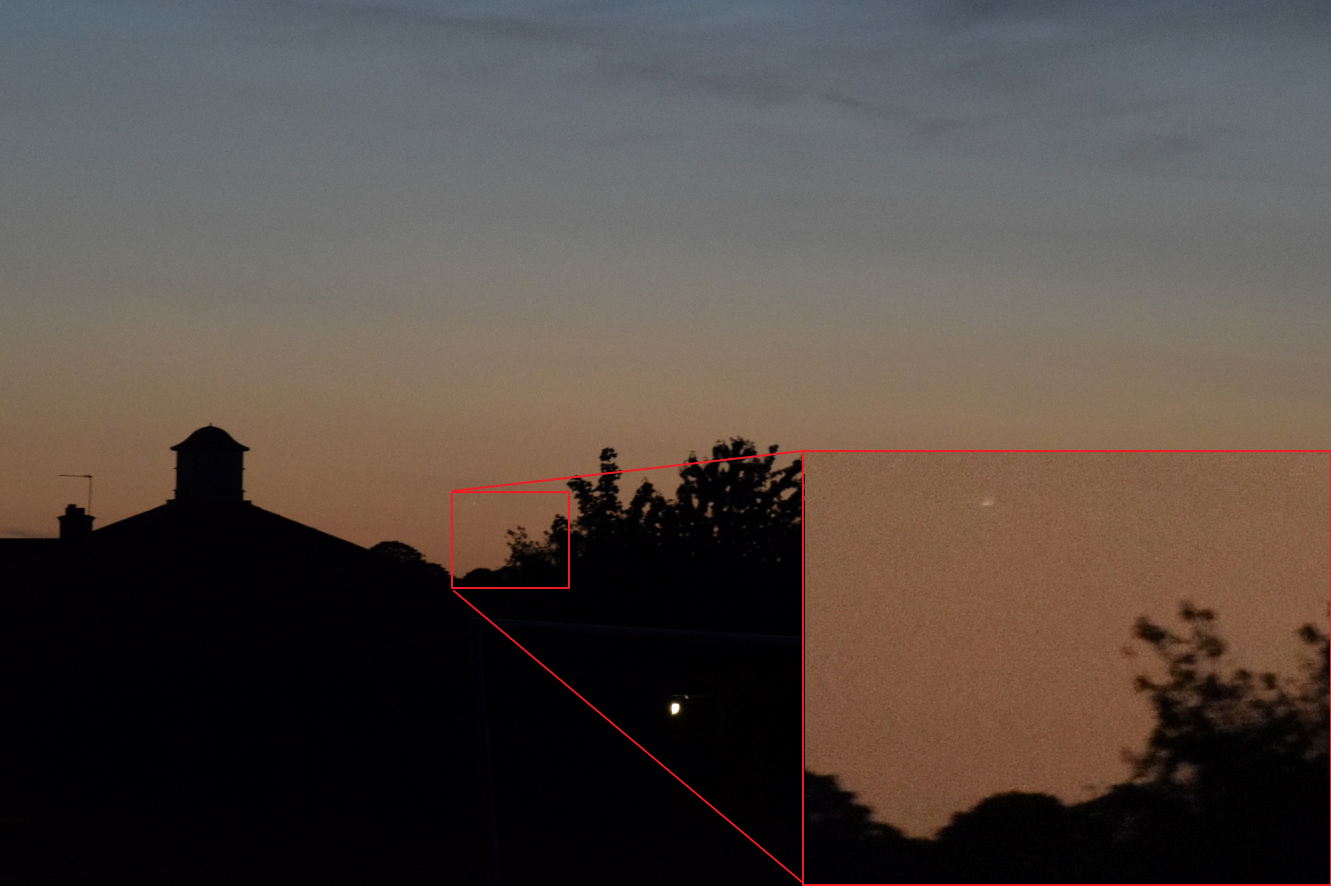
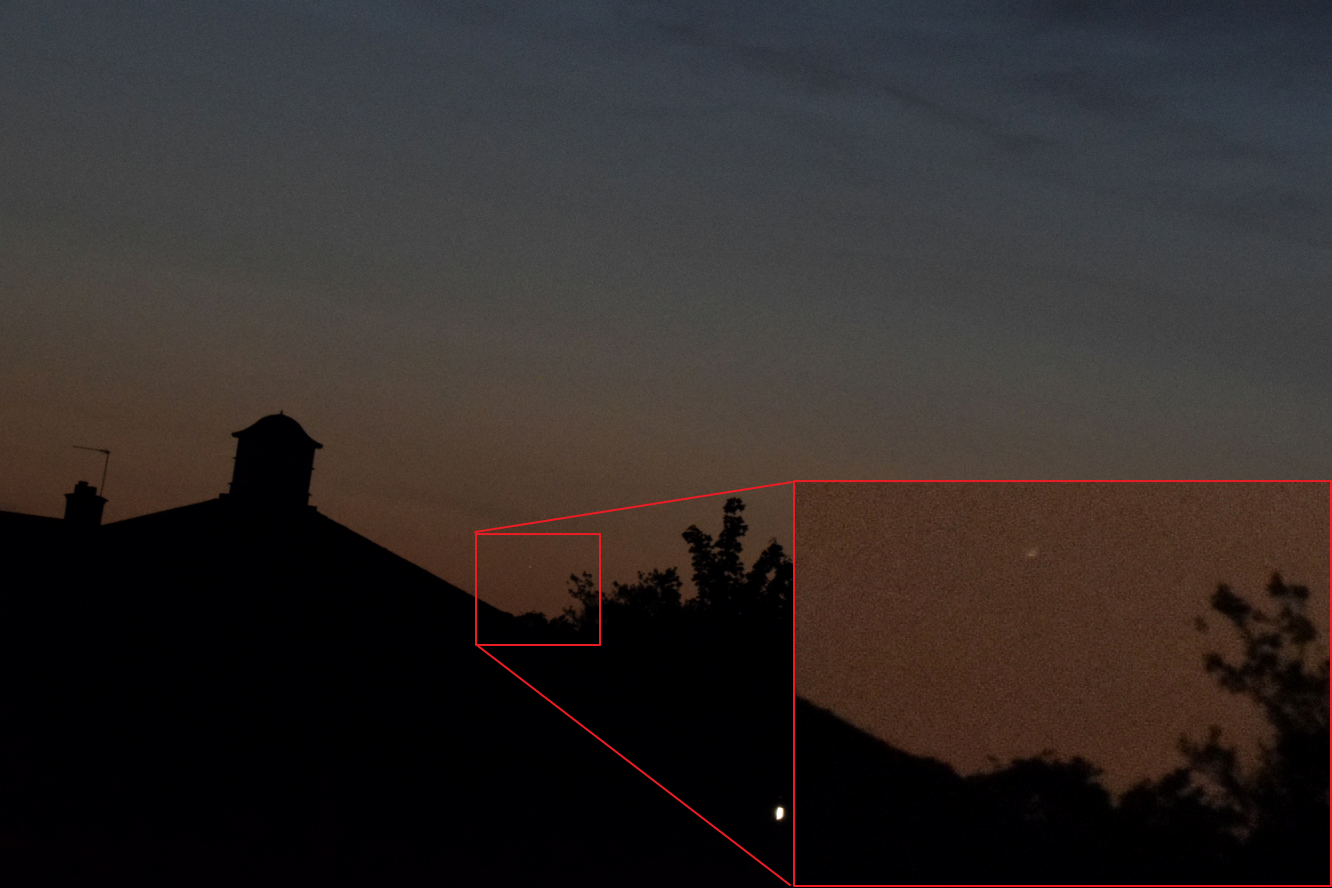
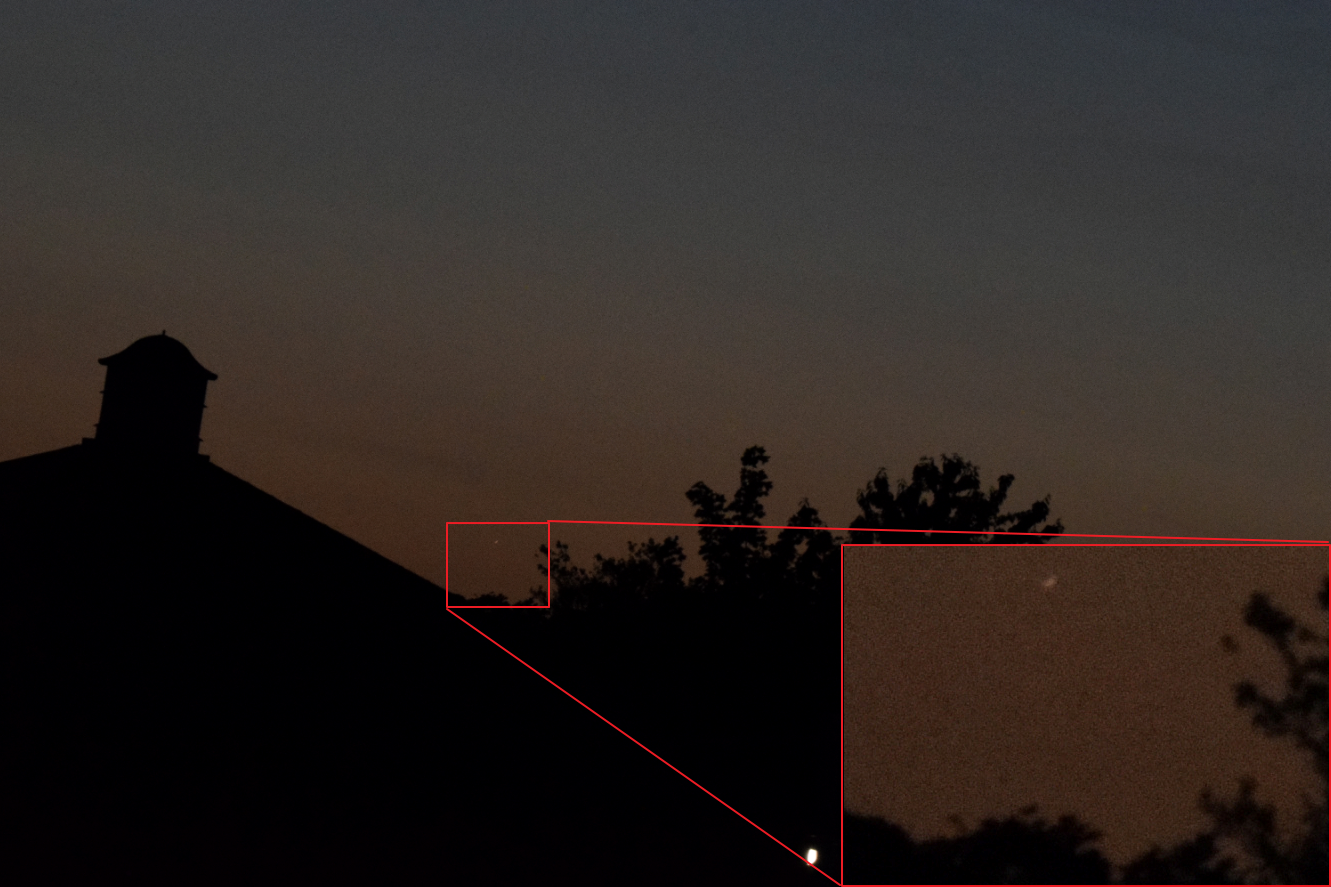
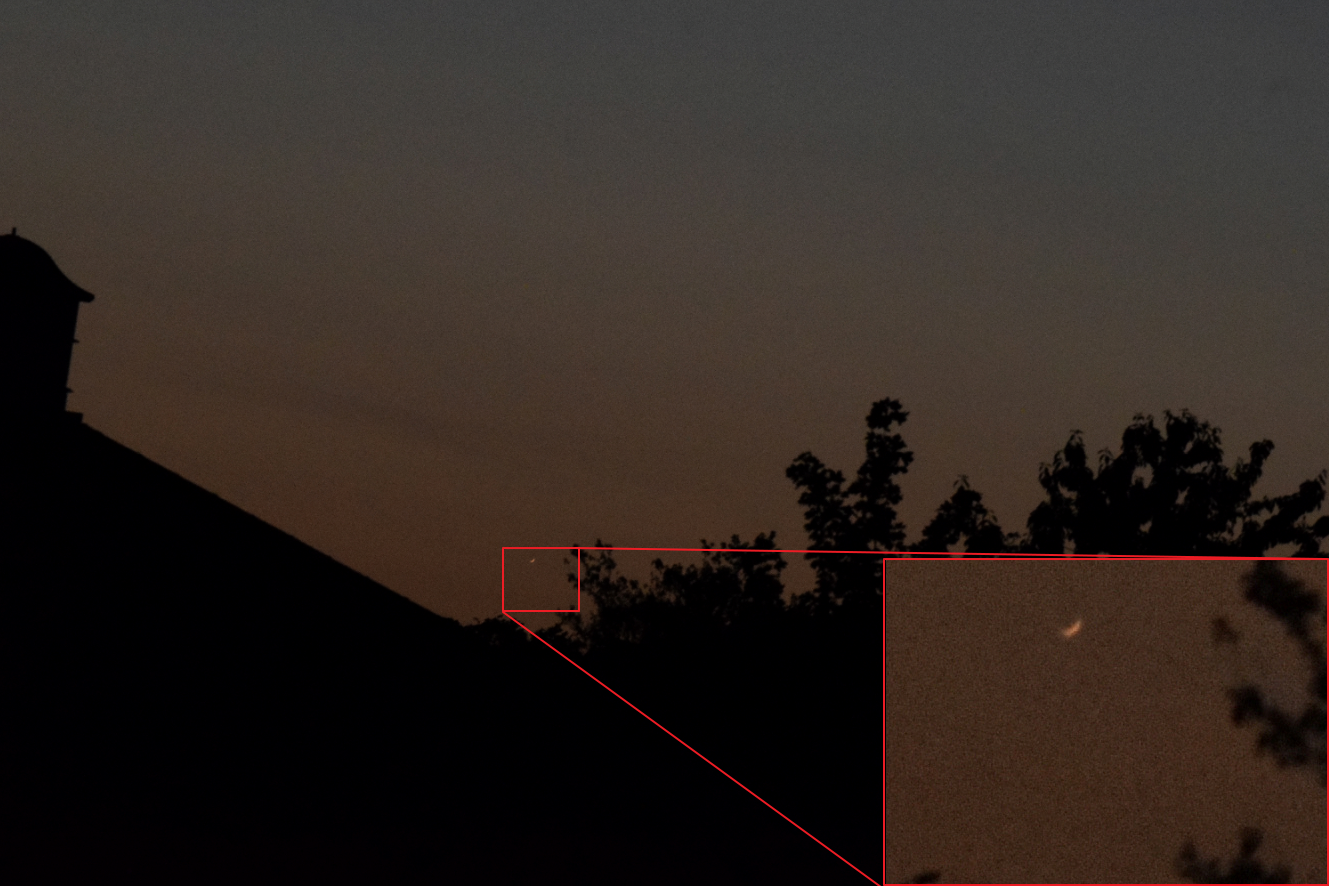

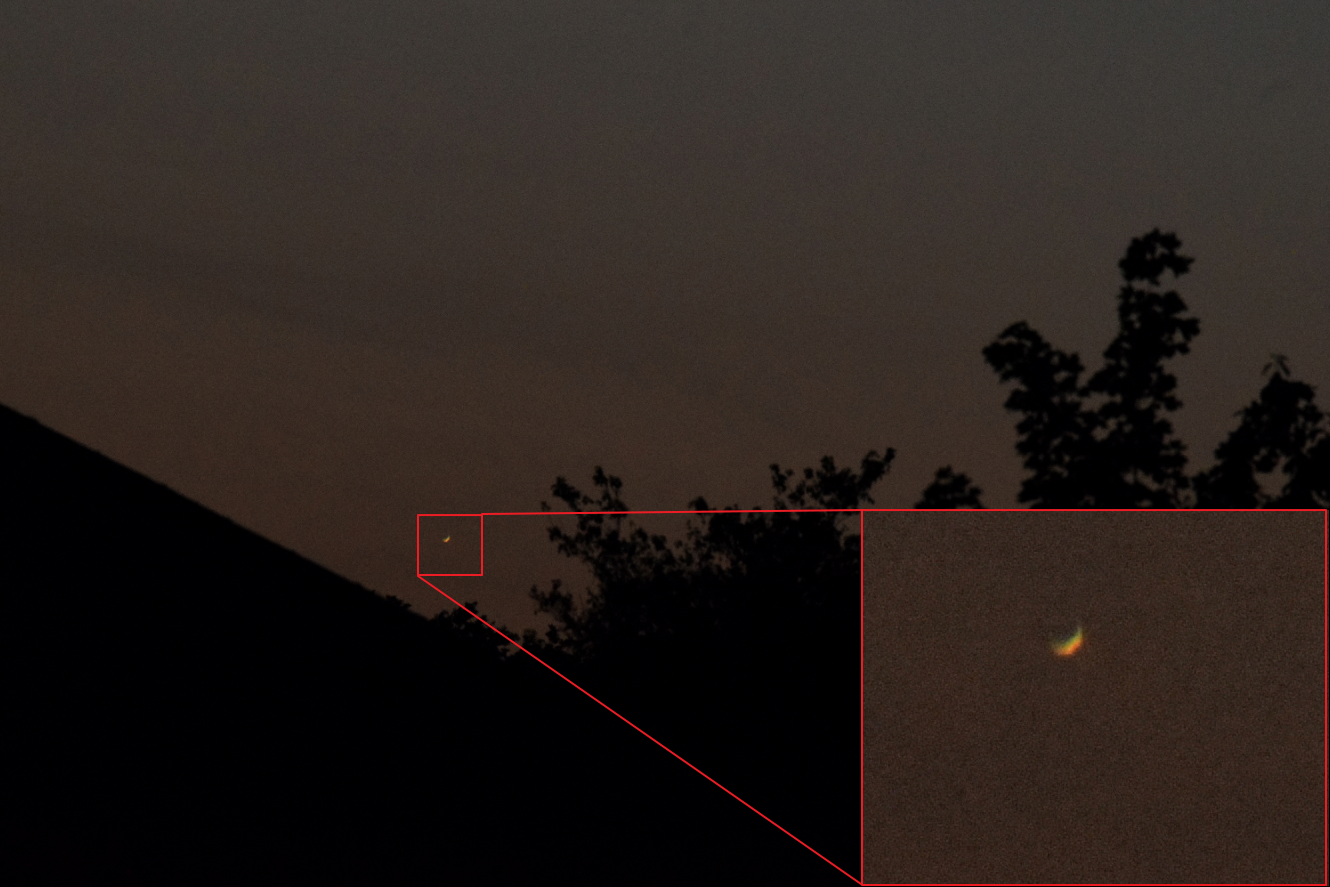
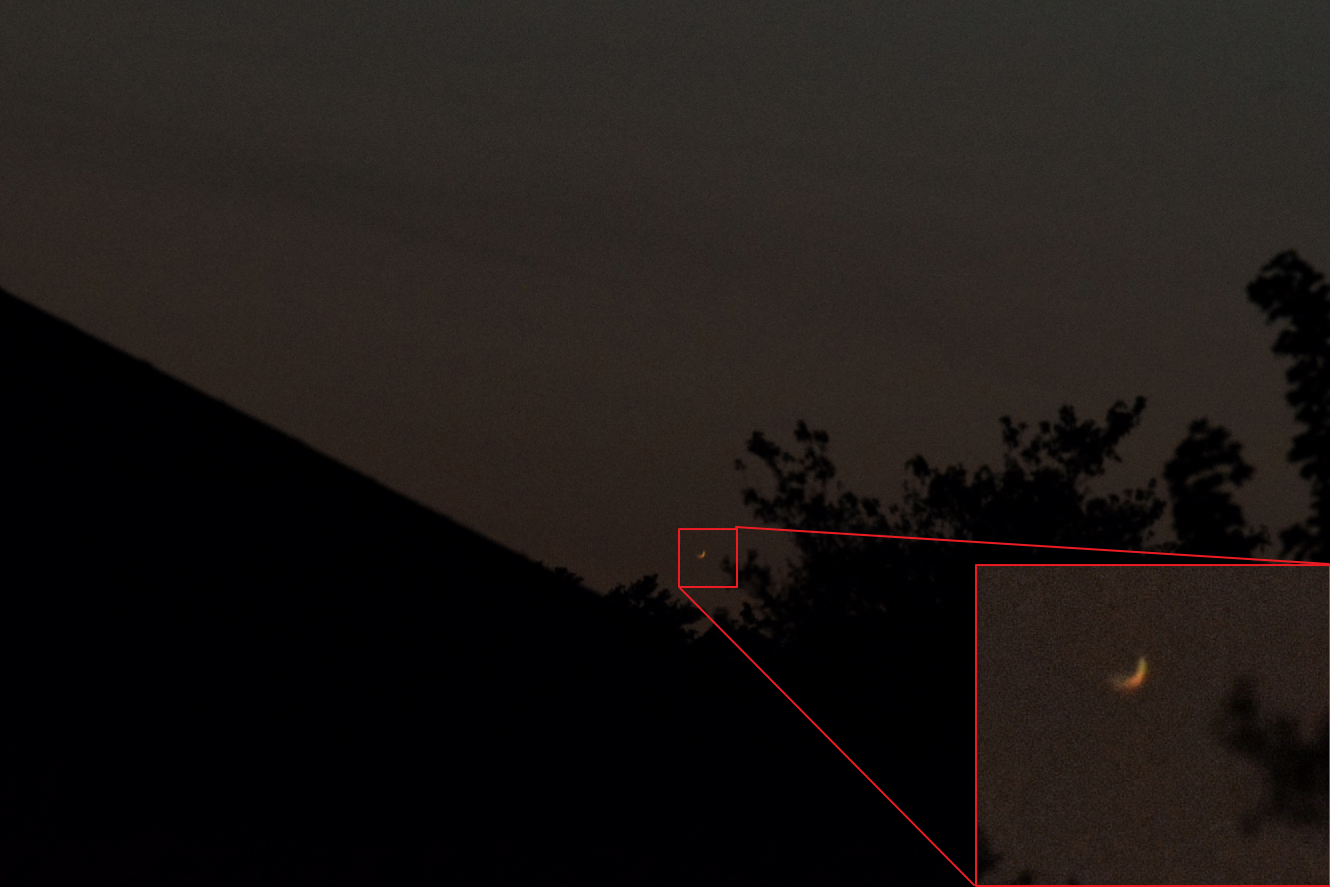
Looking at the images above (Pic. 15 – 24) we can see, that the crescent of Venus starts to be visible from the 135mm focal length when the image is cropped. It’s about 4x magnification to the shortest focal length used in this observation. At 100mm we are able to see the bright Venus spot in the normal image. It’s obviously a false estimation because the brightness of Venus is much smaller than at its maximum when the planet can be captured even by a smartphone (Pic. 5, 6). The most important is the magnification, giving us the possibility to dissolve the shape of Venus.
I continued the observation during the next days…

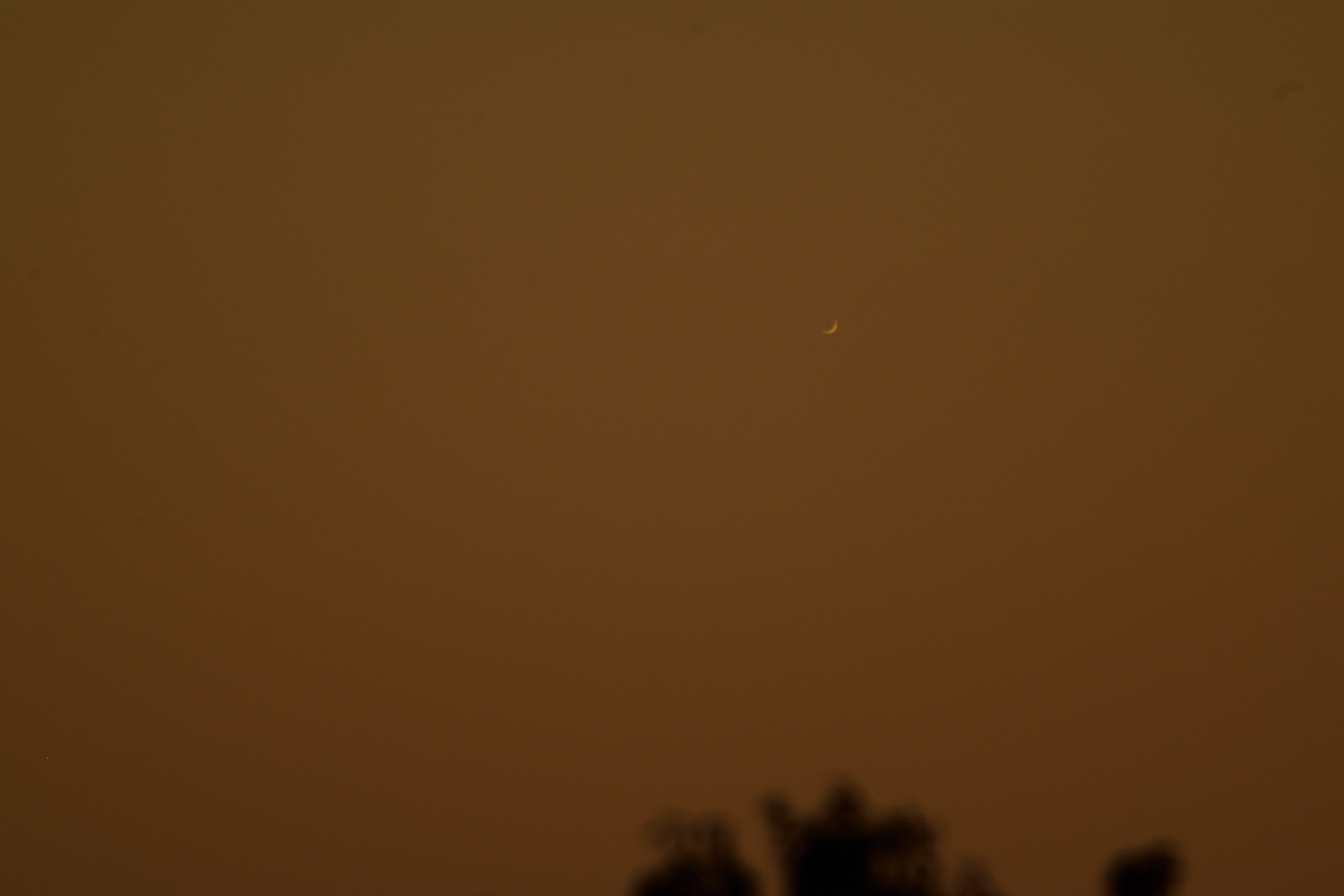

The final of this crescent Venus tracking was so spectacular because I could spot it even on June 1, just 47 hours before its inferior conjunction. The planet, with only 0,1% illumination was barely visible. I couldn’t manage with 1200mm, unfortunately, as an object was too low above the horizon and moved quickly away from the frame. Venus was visible from 300mm upwards. The range of 300-400mm was the best this time. I wish I could try more, but the distant cirrostratus and altostratus clouds cut down about 1.5 degrees of the sky. Anyhow, I am glad, that Venus was visible to me on June 1 (Pic. 28 – 32).

To summarize my Venus chasing before the 2020 inferior conjunction I’ve made an image group below, which displays how the crescent changes throughout the last days before the conjunction. Each image was cropped from 1200mm except for June 1, which was magnified over 2x from 500mm (Pic. 33).
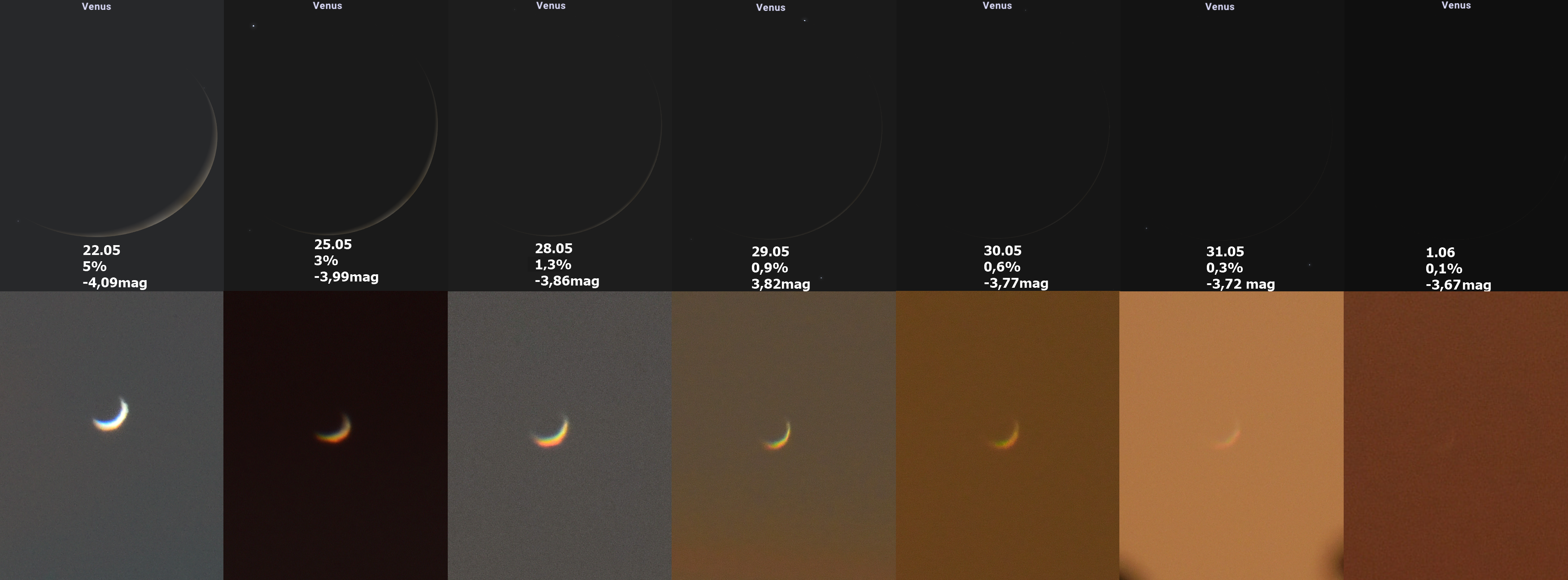
I am happy with my observations, despite their quite poor quality. The TC-2001 teleconverter attached to the Sigma 150-600mm DG OS HSM Contemporary lens isn’t the best item for astrophotography, which the following article is going to be about. However good enough to detect the bright object as Venus is in possibly the less favorable conditions that occurred just before its disappearance on June 1. Contrary to my amateur approach, I would like to show some results from professionalists. They were able to capture a beautiful “annular phase” of Venus.

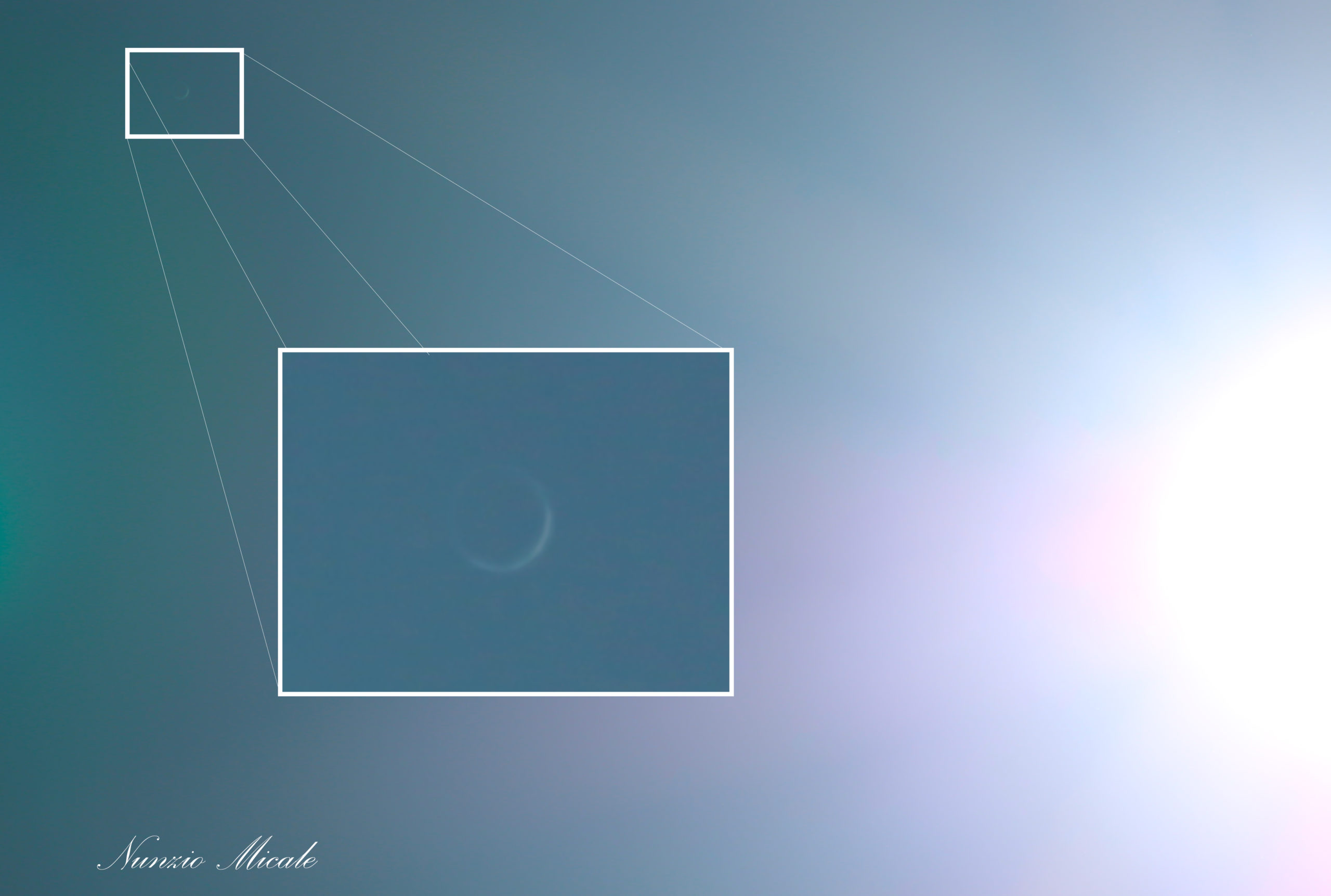

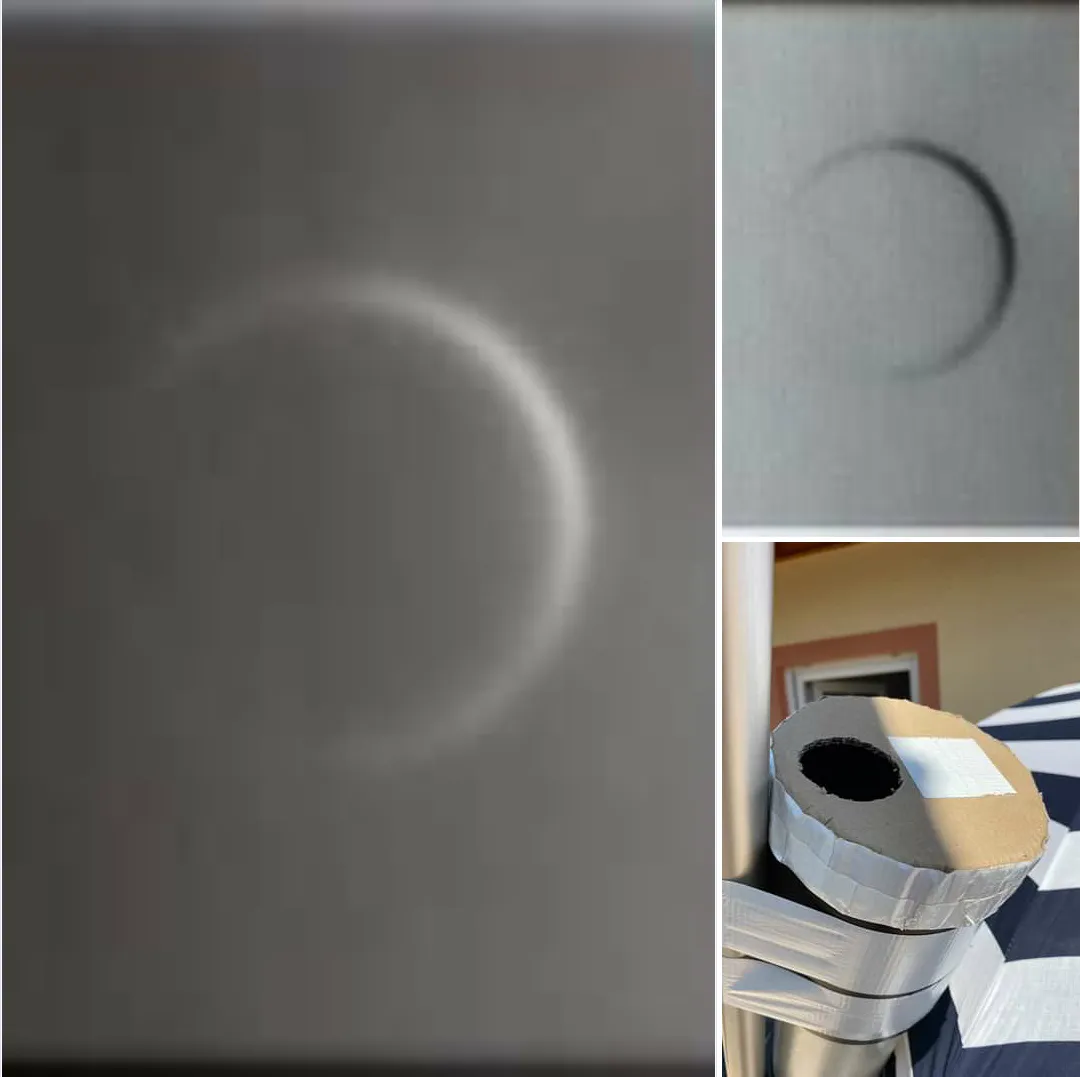
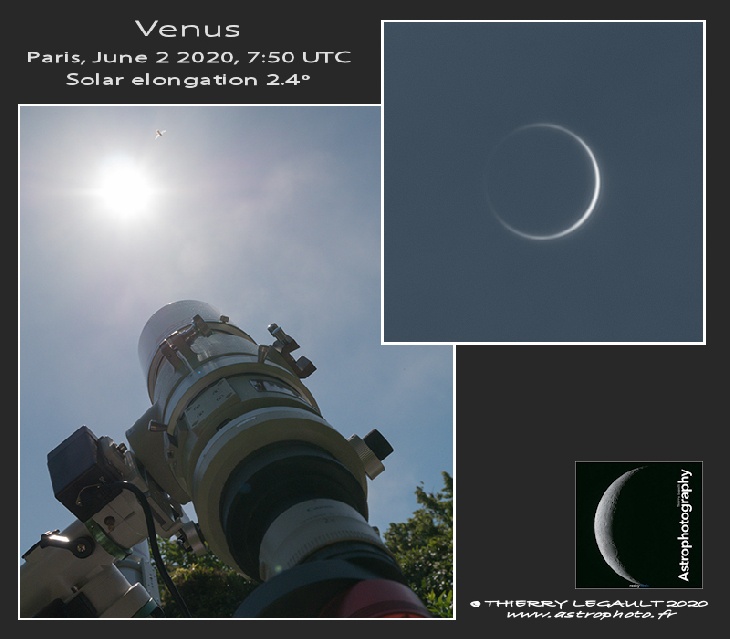
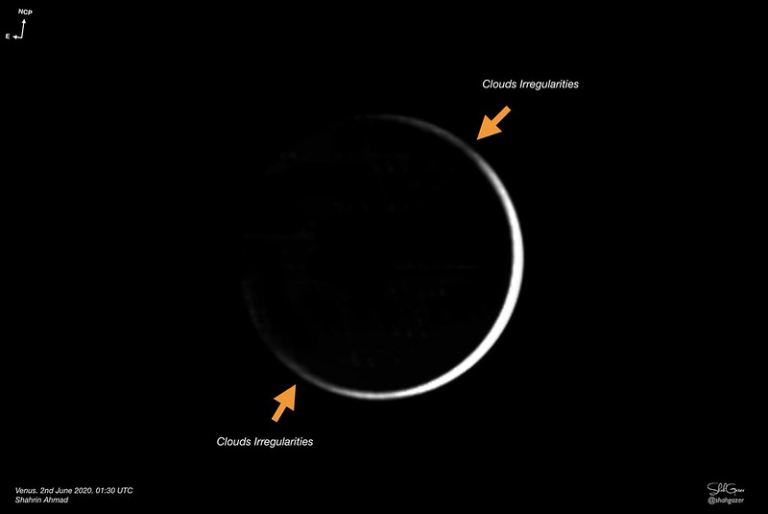
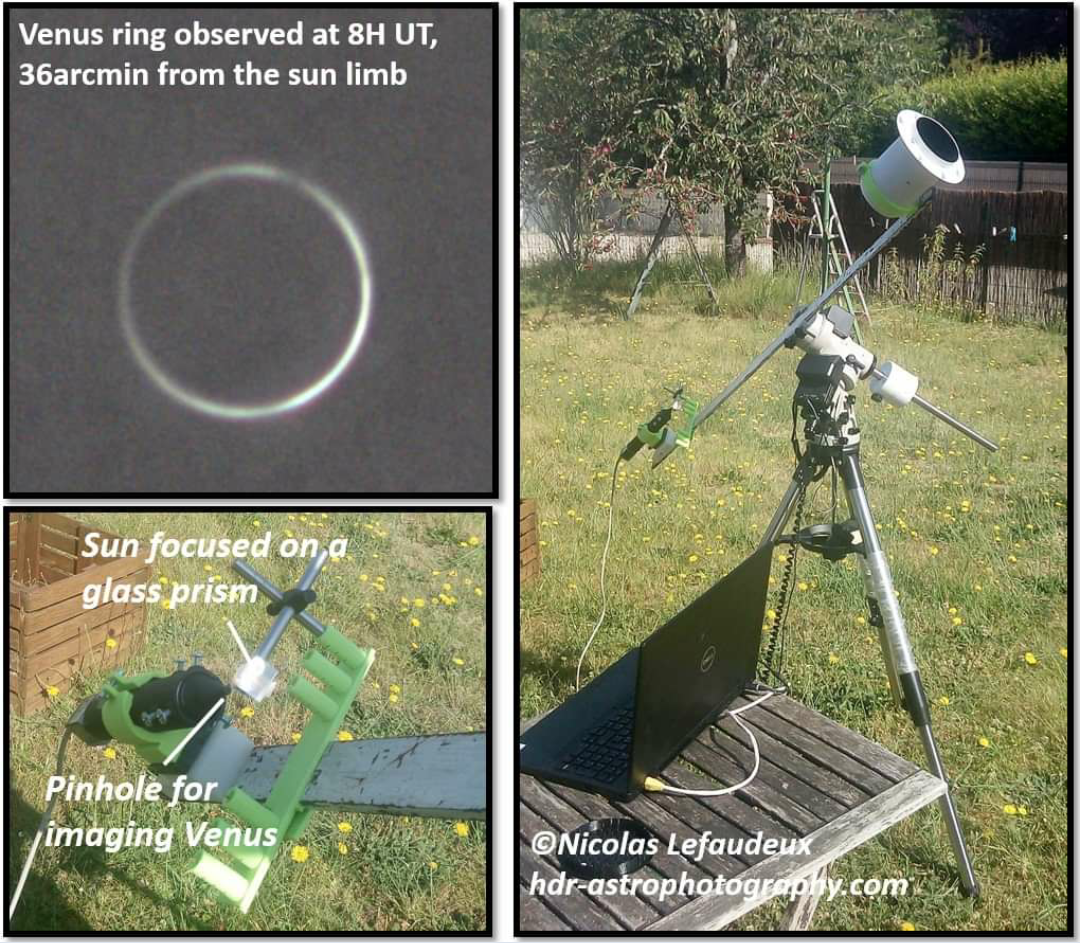
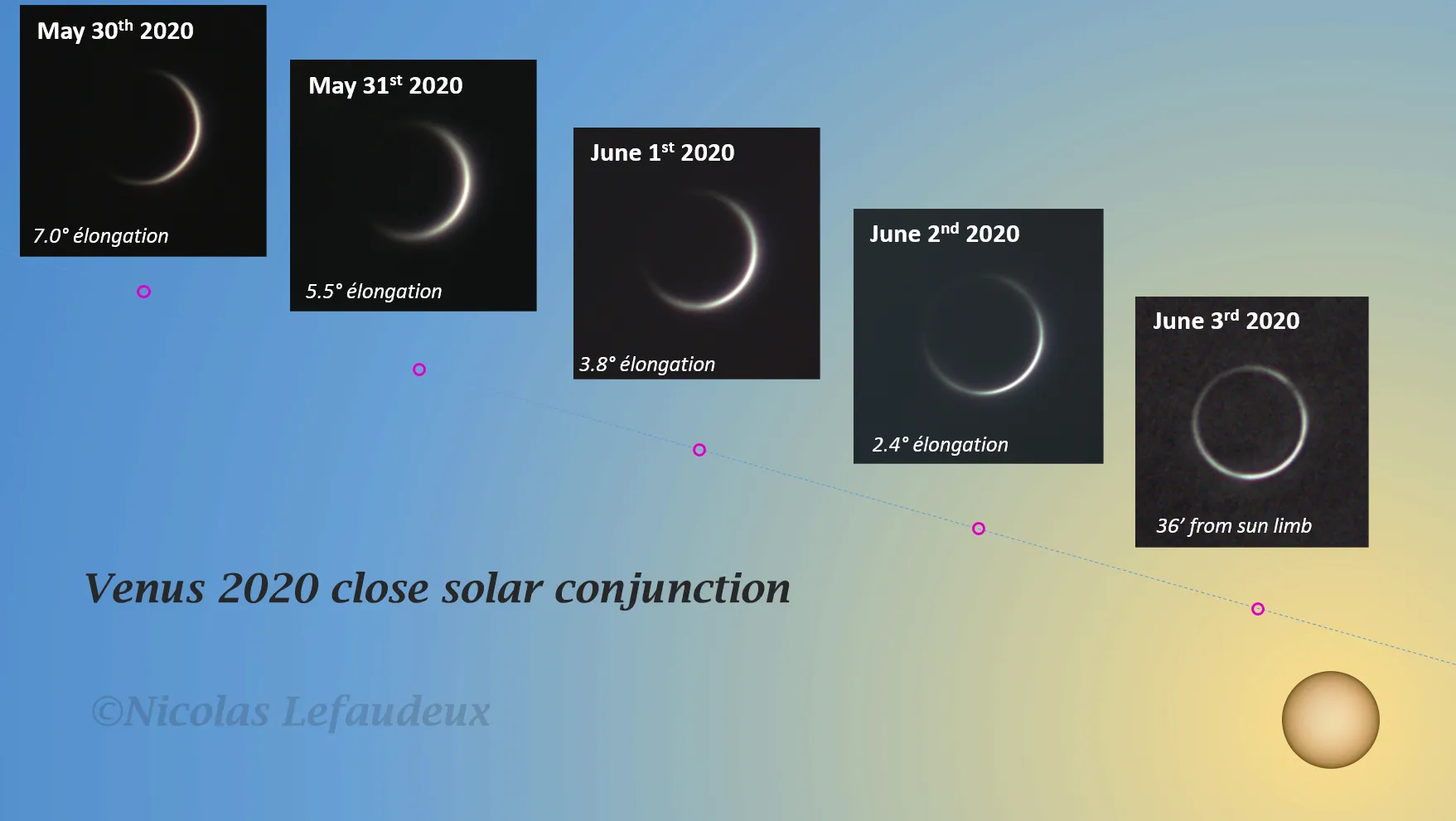
The most unique observation could be Venus passing solar prominence. We could watch it with H-alpha filters. Unfortunately, solar activity was quite low at this time. The prominences were visible, but not at this side, where Venus was located (Pic. 42).

The planet passing the solar limb could be seen via coronographs only (Pic. 43).
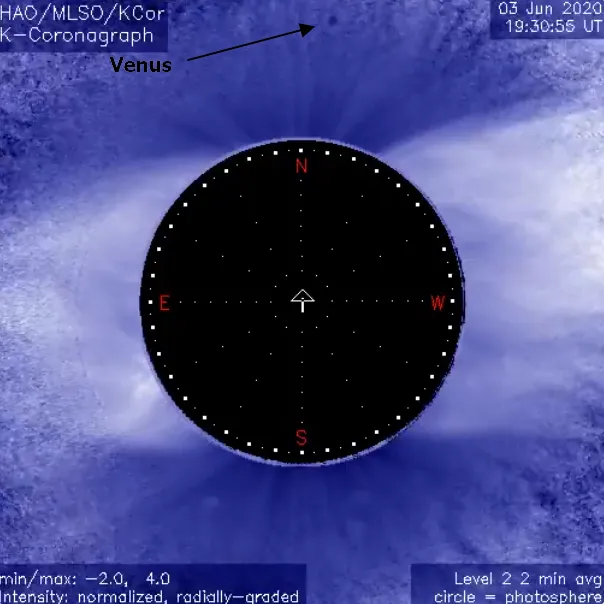
Concluding all these observations was exciting. Both mine, where I was convinced, that Venus can be visible even at the time when I wouldn’t expect and also all these professionals, whose photos have been listed here. Thanks to them I could see the marvelous “ring of fire” produced by the atmosphere of Venus. Obviously, the topic is wide. In the future, I would like to say something more about the ashen light produced by Venus’s shaded side. This is also a very interesting thing. I regret, that capturing Venus passing the solar prominence fell through eventually this time. The next occasion such as this is not as early as December 2109.
Mariusz Krukar
References:
- Curtis H. B., 1936, Venus visible at inferior conjunction, (in:) Popular astronomy, vol. 44, p.18
- Grego P., 2008, Venus and Mercury and how to observe them, Springer Science + Business Media, New York
- Hunten D.M., 1983, Venus, The University of Arizona Press, Tucson
- Price W.F., 2000, The planet observer’s handbook, Cambridge University Press, Cambridge
- Snyder C.W., 1971, Some consequences of critical refraction in the Venus atmosphere, Jet Propulsion Laboratory, Pasadena, USA
- Stratton A.J., 1968, Optical and radio refraction on Venus, (in:) Journal of the atmospheric sciences, vol. 25
Links:
- The 8-year cycle and 5 ‘petals’ of Venus
- 2020, JUNE 3: VENUS AT INFERIOR CONJUNCTION
- https://explainingscience.org/2016/01/10/transit-of-venus-2/
- The inferior conjunction of Venus 2020
- Don’t miss Venus turning into a crescent
- https://astronomiebm.de/en/2020-venus-in-unterer-konjunktion-zur-sonne/
- Venus Passes Between Earth And The Sun
- https://hdr-astrophotography.com/2020-inferior-conjunction-of-venus/
- https://www.universetoday.com/146339/spying-a-rare-ring-of-fire-around-venus-at-inferior-conjunction/
Forums:
- How long will it be light on Venus at night?
- https://astronomy.stackexchange.com/questions/33797/venus-magnitude-during-inferior-conjunction
- https://astronomy.stackexchange.com/questions/23271/how-the-heck-was-this-photo-of-venus-at-inferior-conjunction-between-us-and-t
Wiki:
Youtube:

